The blog describes a visit to Asakusa Kannon Temple and nearby attractions, including Nakamise shopping street, Bandai headquarters, Tokyo Skytree, Odaiba island, and the Lego Discovery Center in Decks shopping mall.
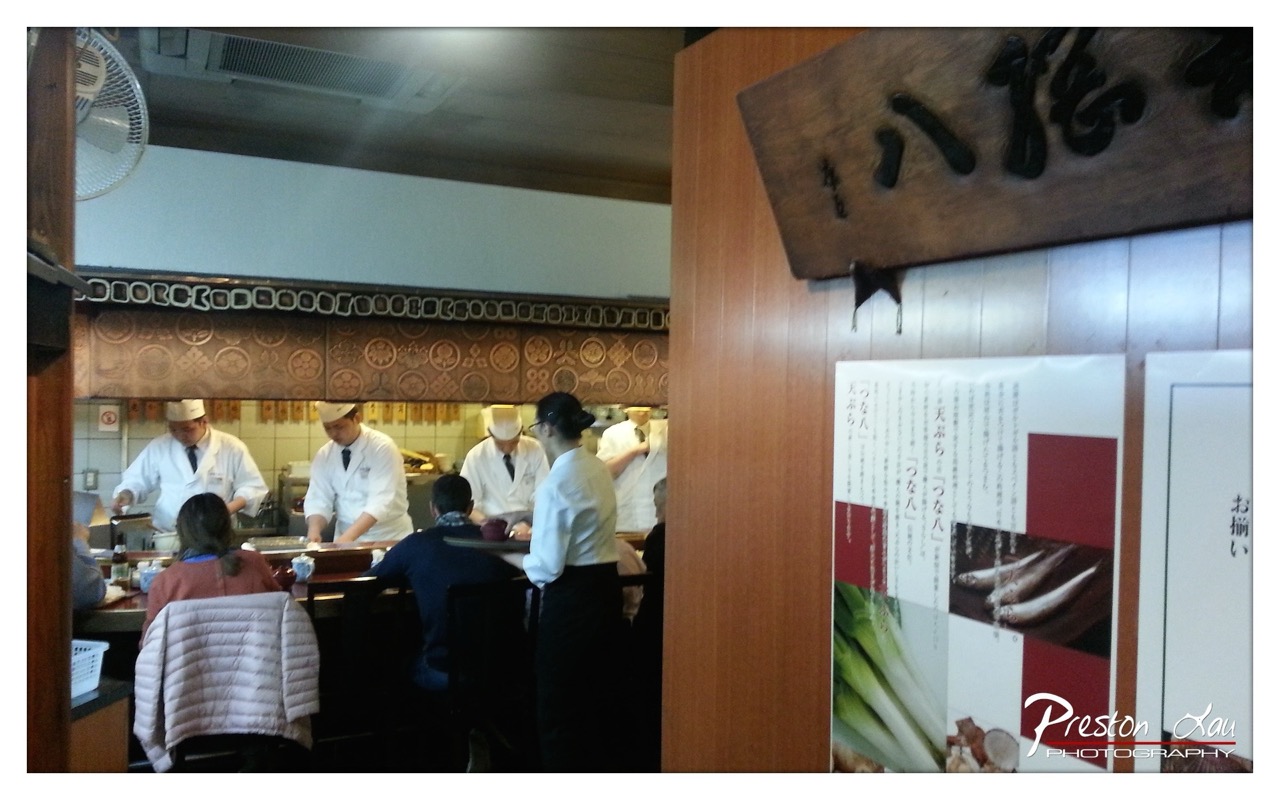

1. Overall Rating (0–10) — 6.8
This photograph captures the intimate, bustling atmosphere of a traditional Japanese sushi restaurant, where the rhythm of preparation unfolds behind a counter. The framing, though slightly off-center, successfully conveys the authenticity of a working kitchen, with chefs in motion and diners engaged in the experience. While the lighting and composition lack a polished aesthetic, the image resonates with a sense of place and cultural specificity, offering a glimpse into a lived moment rather than a staged one.
2. Composition (0–10) — 6.0
The shot is framed by a wooden wall and sign, creating a natural border that draws the eye into the scene. However, the cluttered foreground and asymmetrical balance slightly disrupt the visual flow, making the composition feel more observational than intentional.
3. Lighting (0–10) — 5.5
The lighting is functional and flat, typical of interior fluorescent fixtures, which creates a neutral, documentary-style ambiance. While it captures the scene clearly, it lacks warmth or dramatic contrast, leaving the image feeling somewhat sterile.
4. Color & Tone (0–10) — 6.0
The palette is dominated by whites, browns, and muted tones, reflecting the kitchen’s practical environment. The red accent on the poster provides a subtle pop of color, but the overall tonal range is subdued, limiting visual dynamism.
5. Creativity (0–10) — 7.0
The photographer captures a candid, culturally rich moment with a strong sense of context. The inclusion of the wooden sign and menu adds narrative depth, making the image more than a simple snapshot—it feels like a cultural document.
6. Technical Quality (0–10) — 7.5
The image is sharp and well-focused, with clear details in both the foreground and background. The exposure is balanced, and there is minimal noise, indicating good technical execution despite the challenging lighting.
7. Emotional Impact (0–10) — 6.5
The image evokes a quiet sense of tradition and dedication, particularly through the chefs’ focused work. While it doesn’t elicit strong emotional resonance, it invites contemplation of the ritualistic nature of Japanese dining and the human effort behind it.
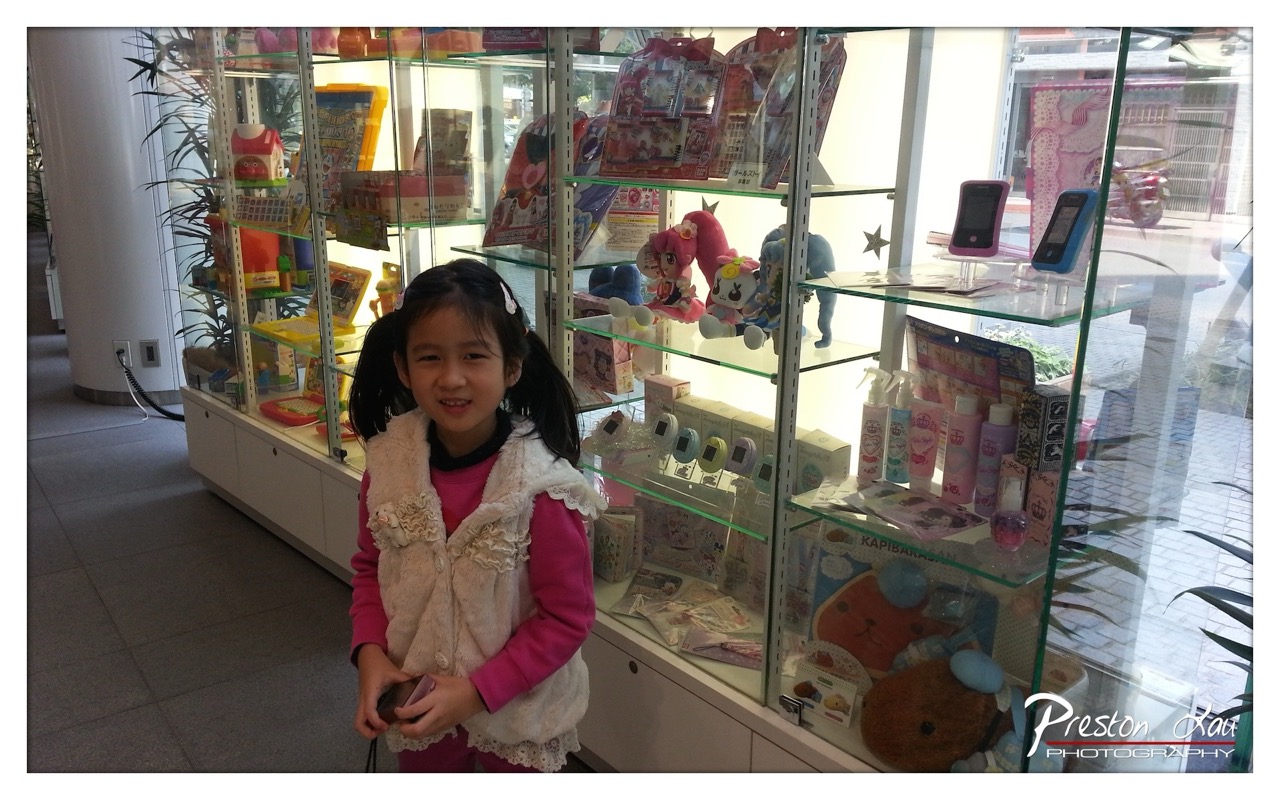

1. Overall Rating (0–10) — 6.0
This photograph captures a candid moment of a young girl in a brightly lit toy store, her smile conveying genuine delight. The scene is lively and colorful, with a sense of playful innocence that draws the viewer in. While the composition is somewhat cluttered and the lighting is flat, the image succeeds in conveying a warm, everyday moment of childhood joy.
2. Composition (0–10) — 5.5
The girl is positioned slightly off-center, and the glass display cases create a layered, busy background that competes for attention. A tighter crop would help emphasize the subject and reduce visual distraction.
3. Lighting (0–10) — 5.0
The scene is evenly lit by ambient indoor light, but the reflections on the glass shelves and the lack of directional light flatten the image and diminish depth.
4. Color & Tone (0–10) — 7.0
The palette is vibrant, dominated by pinks, yellows, and pastel tones that reflect the playful nature of the setting. The colors are lively and consistent with the subject matter, though some saturation feels slightly overdone.
5. Creativity (0–10) — 6.0
The photograph captures a relatable, slice-of-life moment with charm and authenticity. However, it lacks a distinctive artistic vision, relying more on the subject’s expression than on deliberate visual storytelling.
6. Technical Quality (0–10) — 7.5
The image is sharp and clear, with good focus on the girl and adequate detail throughout. The white balance is neutral, and the exposure is well-managed despite the reflective surfaces.
7. Emotional Impact (0–10) — 7.0
The girl’s warm smile and the joyful setting evoke a strong sense of childhood wonder and happiness. The viewer is invited into a moment of simple, unguarded delight.
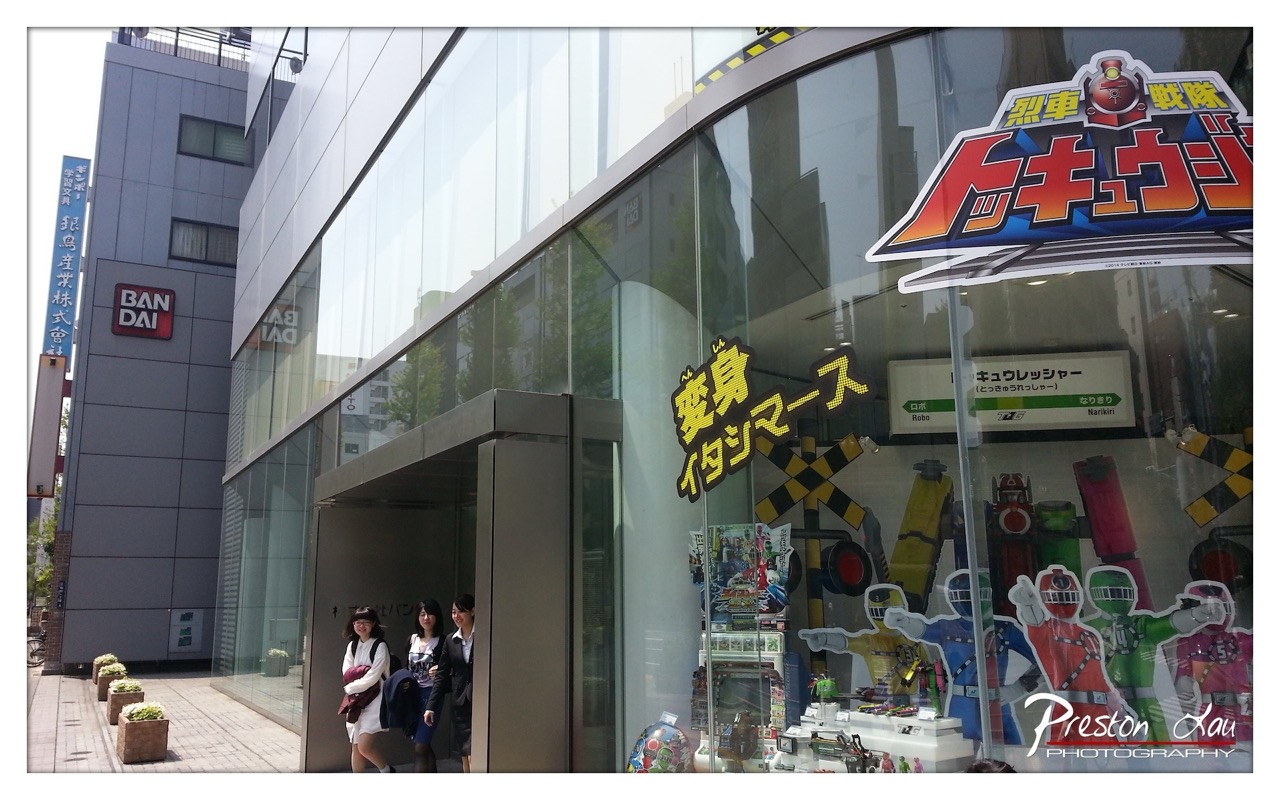

1. Overall Rating (0–10) — 6.8
This photograph captures a vibrant urban moment where pop culture and daily life intersect, with the colorful display of *Tetsujin 28* and *Kyuranger* toys creating a playful contrast against the sleek, modern architecture of the Bandai building. The composition is engaging, with the bright signage drawing the eye and the casually walking women adding a sense of motion and relatability. While the image succeeds in conveying a lively street scene, its visual impact is slightly diminished by the overexposed sky and the somewhat busy framing, which compete for attention rather than harmonize.
2. Composition (0–10) — 6.5
The image uses a wide-angle perspective to include both the building facade and the street-level activity, but the composition feels slightly unbalanced due to the dominant diagonal of the glass wall and the off-center placement of the main signage. The figures in the foreground provide a natural focal point, though their small scale reduces their visual weight. A tighter crop might have strengthened the narrative focus.
3. Lighting (0–10) — 6.0
Natural daylight provides even illumination, though the sky is overexposed, washing out details in the upper portion of the frame. The reflections on the glass add complexity but also create some visual clutter. The lighting enhances the colors of the display without creating harsh shadows, though the overall brightness reduces tonal depth.
4. Color & Tone (0–10) — 7.5
The palette is rich and dynamic, with the bright reds, blues, and yellows of the toy display standing out against the neutral grays and silvers of the building. The color contrast is strong and immediately draws attention to the commercial display. The tones are generally well-balanced, though the overexposed sky slightly flattens the overall atmosphere.
5. Creativity (0–10) — 7.0
The photograph captures a unique cultural juxtaposition—Japanese pop culture on display in an urban retail setting—offering a glimpse into the integration of entertainment and everyday life. The choice to include pedestrians adds narrative depth, and the bold signage provides a sense of place and identity. While the concept is strong, the execution remains somewhat conventional.
6. Technical Quality (0–10) — 7.0
The image is sharp and well-focused, with clear detail in the signage and building materials. The exposure is generally accurate, though the overexposed sky suggests a slight limitation in dynamic range. The watermark is visible but does not detract significantly from the overall quality.
7. Emotional Impact (0–10) — 6.5
The image evokes a sense of curiosity and nostalgia, particularly for fans of Japanese tokusatsu and toy culture. The casual presence of the women adds a human element, suggesting a moment of ordinary life intersecting with extraordinary entertainment. While the emotional resonance is present, it remains subdued due to the distance created by the commercial setting and the photograph’s documentary tone.
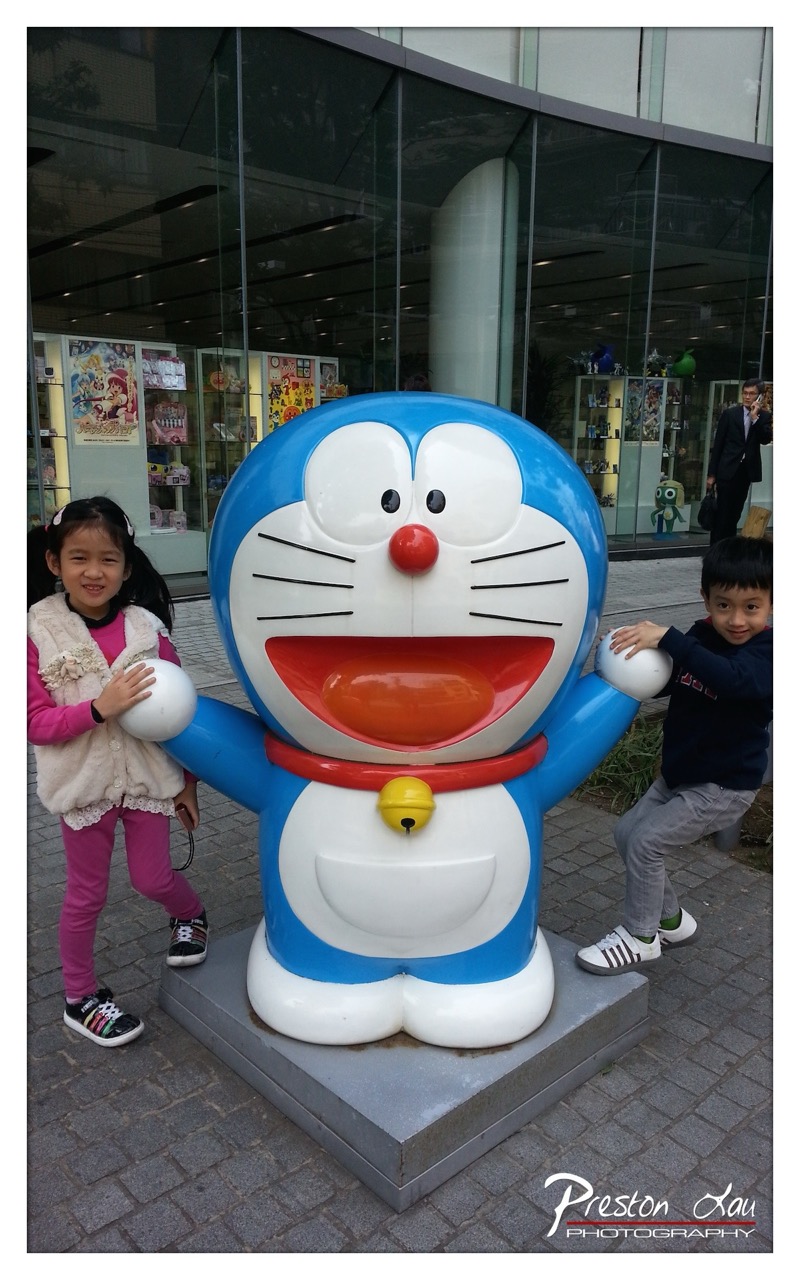

1. Overall Rating (0–10) — 7.0
This photograph captures a joyful, candid moment of two children posing with a life-sized Doraemon statue, evoking a sense of wonder and nostalgia. The vibrant colors of the character contrast beautifully with the muted urban backdrop, creating a playful and inviting scene. While the composition is slightly cluttered and the lighting is flat, the genuine expressions of the children lend warmth and authenticity to the image.
2. Composition (0–10) — 6.0
The central placement of the Doraemon statue anchors the image, but the children are slightly off-center, creating a dynamic yet unbalanced feel. The background elements, including the glass storefront and passing pedestrian, distract slightly from the main subjects.
3. Lighting (0–10) — 5.5
The lighting is even and diffused, likely from an overcast sky, which minimizes harsh shadows but also flattens the scene’s depth. The lack of directional light softens the colors and reduces visual contrast.
4. Color & Tone (0–10) — 7.5
The bright blue and red of Doraemon stand out vividly against the neutral grays and muted tones of the pavement and building. The color palette is lively and engaging, enhancing the playful mood of the image.
5. Creativity (0–10) — 6.5
The image successfully captures a moment of childhood delight, blending pop culture with everyday life. While the concept is familiar, the candid nature of the children’s interaction adds a layer of authenticity and charm.
6. Technical Quality (0–10) — 7.0
The focus is sharp on the statue and children, with clear details in the textures of clothing and the statue’s surface. The image is well-exposed, though the flat lighting limits tonal richness.
7. Emotional Impact (0–10) — 7.5
The genuine smiles and playful poses of the children evoke a strong sense of joy and nostalgia, making the image emotionally resonant and relatable, especially for fans of the character.
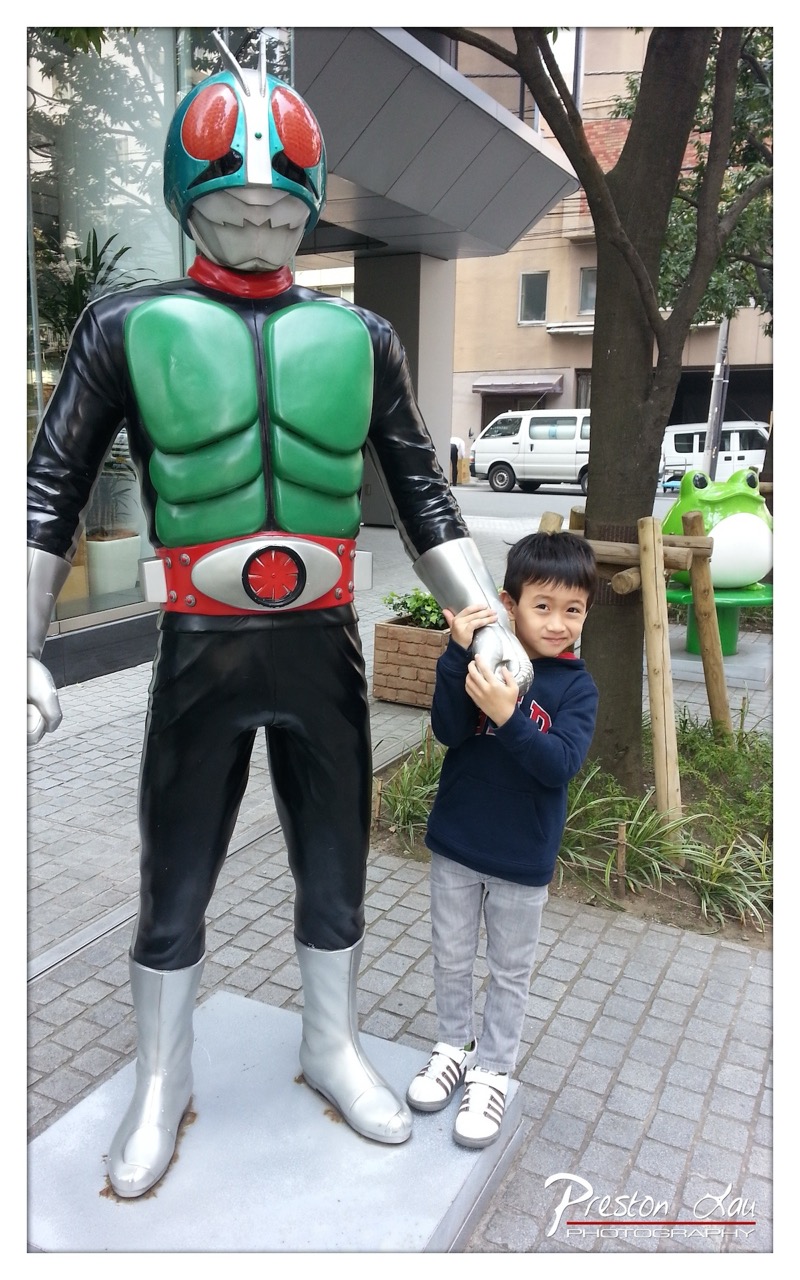

1. Overall Rating (0–10) — 7.0
This photograph captures a heartwarming moment of childhood wonder as a young boy interacts with a life-sized Kamen Rider statue, blending pop culture nostalgia with genuine emotion. The vibrant colors of the costume contrast beautifully with the muted urban backdrop, creating a visually engaging scene. While the composition is slightly cluttered and the lighting is flat, the image succeeds in conveying a sense of joy and connection to a beloved fictional world.
2. Composition (0–10) — 6.0
The subject is well-placed, with the boy and statue forming a natural focal point, but the background includes distracting elements like the white van and tree trunk that interrupt visual flow. A tighter crop could enhance focus on the interaction.
3. Lighting (0–10) — 5.5
Natural daylight provides even illumination, though it lacks depth and direction, resulting in flat tones and minimal shadow definition. The overcast conditions contribute to a muted atmosphere.
4. Color & Tone (0–10) — 7.5
The bold green, red, and silver of the Kamen Rider costume pop against the neutral pavement and foliage, creating a dynamic and playful palette. The overall tone is balanced, with colors that feel authentic to the scene.
5. Creativity (0–10) — 7.0
The image successfully captures a personal, narrative moment, transforming a simple tourist photo into a story of admiration and imagination. The juxtaposition of a real child with a fictional hero adds a layer of whimsy and cultural resonance.
6. Technical Quality (0–10) — 7.5
The image is sharp and well-focused, with clean details in both the boy’s face and the statue’s surface. The exposure is accurate, and the photographer’s signature is subtly placed, not distracting.
7. Emotional Impact (0–10) — 8.0
The boy’s genuine smile and the tender way he holds the statue’s hand evoke warmth and nostalgia, creating a strong emotional connection with the viewer. The image feels authentic and deeply human.
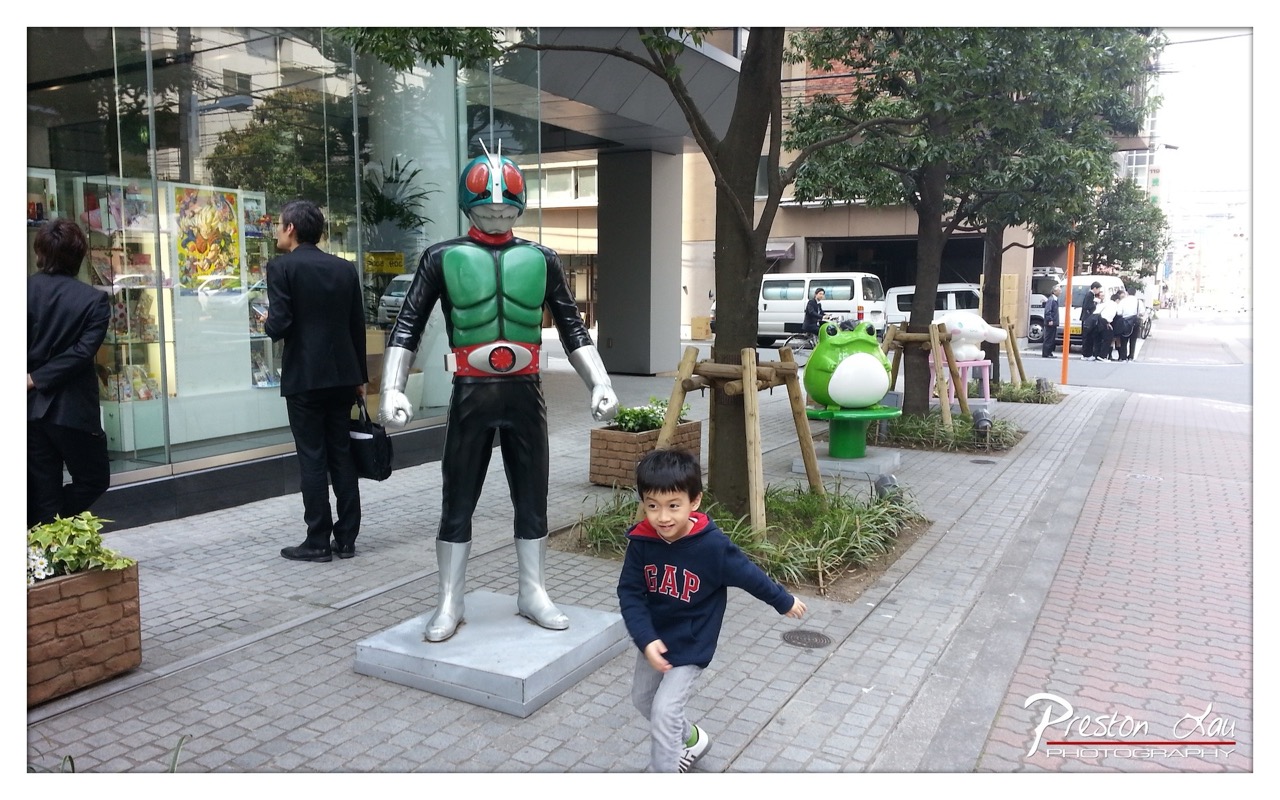

1. Overall Rating (0–10) — 6.8
This photograph captures a playful juxtaposition of childhood wonder and pop-culture iconography, with a young boy seemingly running toward the viewer in front of a life-sized Kamen Rider statue. The candid energy of the child contrasts beautifully with the static, heroic pose of the figure, creating a moment that feels both spontaneous and symbolic. While the scene is visually engaging and rich with cultural context, the composition is slightly cluttered, and the lighting lacks depth, preventing the image from achieving a more refined emotional resonance.
2. Composition (0–10) — 6.0
The boy is well-placed in the foreground, drawing the eye, but the Kamen Rider statue and surrounding elements—such as the tree, planter, and background pedestrians—create a busy, uneven frame. A tighter crop or more deliberate framing would better focus attention on the central interaction.
3. Lighting (0–10) — 5.5
The scene is lit with flat, overcast daylight, which softens shadows and reduces visual drama. While this allows for even exposure, it also flattens the image’s depth and diminishes the texture of the statue and surroundings.
4. Color & Tone (0–10) — 6.5
The bright green and red of the Kamen Rider suit stand out against the muted urban palette of grays and greens. The colors are vibrant enough to draw attention but lack tonal richness, with the overall image appearing slightly washed out.
5. Creativity (0–10) — 7.0
The image is conceptually strong, capturing a unique blend of Japanese pop culture and everyday life. The candid moment of the boy’s movement adds a layer of narrative and spontaneity, making the photograph feel both personal and culturally resonant.
6. Technical Quality (0–10) — 7.5
The focus is sharp on the boy and the statue, with good detail in the textures of clothing and the statue’s surface. The exposure is balanced, and the image is free from major technical flaws, though some areas of the background appear slightly overexposed.
7. Emotional Impact (0–10) — 7.0
The image evokes a sense of joy and nostalgia, with the child’s expression and motion suggesting excitement and play. The presence of the Kamen Rider figure adds a layer of fantasy, making the viewer reflect on childhood imagination and the power of iconic characters to inspire real-world wonder.


1. Overall Rating (0–10) — 7.0
This photograph captures a joyful, candid moment of two children posing with a towering Ultraman statue, evoking nostalgia and childhood wonder. The vibrant colors of the statue contrast beautifully with the muted urban backdrop, creating a visually engaging scene that feels both playful and heartfelt. While the composition is slightly cluttered by the surrounding environment, the genuine smiles and connection to the iconic figure give the image a strong sense of personality and warmth.
2. Composition (0–10) — 6.5
The children are well-placed in the foreground, drawing immediate attention, but the wide framing includes excess background elements that distract from the central subject. The statue’s imposing presence dominates the frame, but the off-center placement of the children slightly disrupts balance.
3. Lighting (0–10) — 7.0
Natural daylight provides even, soft illumination across the scene, enhancing the reflective surface of the statue and highlighting the children’s expressions. The overcast sky minimizes harsh shadows, creating a balanced exposure that suits the casual, outdoor setting.
4. Color & Tone (0–10) — 8.0
The bold red and silver of the Ultraman statue stand out vividly against the neutral tones of the pavement and building. The children’s bright pink and navy clothing add to the palette’s energy, while the green foliage introduces a natural counterpoint, creating a harmonious and lively color scheme.
5. Creativity (0–10) — 7.5
The image successfully blends pop culture with everyday life, capturing a moment that is both personal and universally relatable. The choice to photograph children interacting with a beloved character adds a layer of storytelling and emotional resonance that elevates the image beyond a simple souvenir shot.
6. Technical Quality (0–10) — 8.0
The photograph is sharp and well-focused, with clear detail visible in the subjects’ faces, the statue’s surface, and the surrounding environment. The depth of field is sufficient to keep both the children and the statue in focus while softly blurring the background.
7. Emotional Impact (0–10) — 8.0
The genuine smiles and playful interaction with the statue convey a sense of joy and wonder, evoking feelings of nostalgia and innocence. The image resonates emotionally by capturing a fleeting moment of childhood delight in a recognizable cultural context.
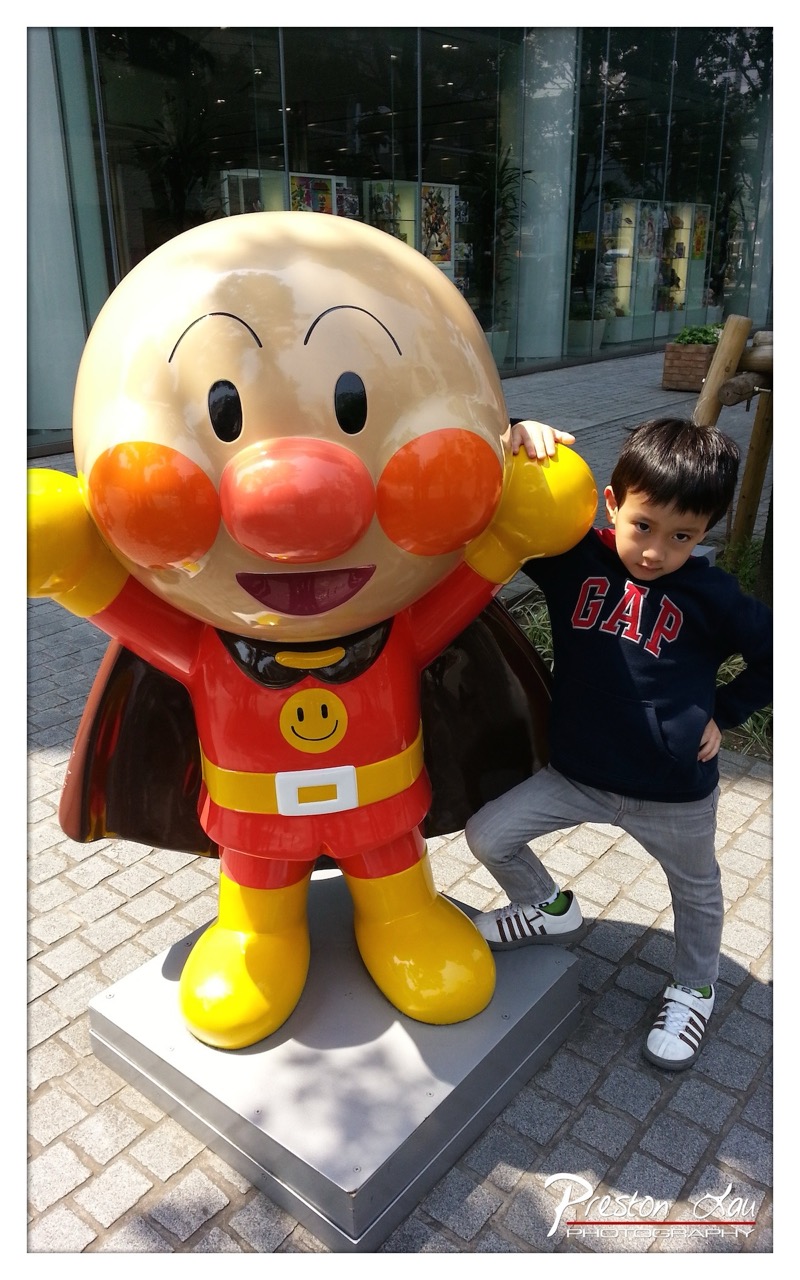

1. Overall Rating (0–10) — 7.0
This photograph captures a joyful, candid moment between a child and a beloved cartoon character, radiating warmth and youthful energy. The bright colors of the Anpanman statue contrast playfully with the child’s casual outfit, creating a lively, almost storybook atmosphere. While the image is charming and well-composed, the background clutter slightly distracts from the emotional focus, and the lighting, though natural, lacks depth to fully elevate the scene.
2. Composition (0–10) — 7.0
The child is positioned slightly off-center, leaning into the frame, which creates a sense of movement and engagement. The statue dominates the left side, providing a strong visual anchor, while the boy’s pose adds dynamism. The cobblestone pavement and background glass reflect a real-world setting, grounding the whimsy in authenticity.
3. Lighting (0–10) — 7.0
Natural daylight illuminates the scene evenly, highlighting the glossy surface of the statue and casting soft shadows. The light enhances the vibrancy of the colors without creating harsh contrasts, contributing to the photograph’s cheerful mood.
4. Color & Tone (0–10) — 8.0
The palette is rich and harmonious, with the red, yellow, and orange of the statue creating a vivid focal point. The child’s navy blue sweatshirt and grey pants provide a neutral contrast that allows the colors to pop. The overall tone is bright and uplifting, reinforcing the playful theme.
5. Creativity (0–10) — 7.0
The image captures a personal, authentic moment rather than a staged portrait, giving it a genuine emotional quality. The juxtaposition of a real child with a larger-than-life cartoon figure adds a layer of imaginative storytelling, making the photograph feel both relatable and whimsical.
6. Technical Quality (0–10) — 8.0
The focus is sharp on the child and the statue, with clear details in the textures of the clothing and the statue’s surface. The exposure is well-balanced, and the image is free of noticeable noise or blur, demonstrating strong technical execution.
7. Emotional Impact (0–10) — 7.5
The photograph evokes a sense of childhood wonder and delight, with the child’s confident pose and the cheerful expression of the statue creating a shared moment of joy. It resonates with viewers who appreciate nostalgia, family, and the magic of simple pleasures.
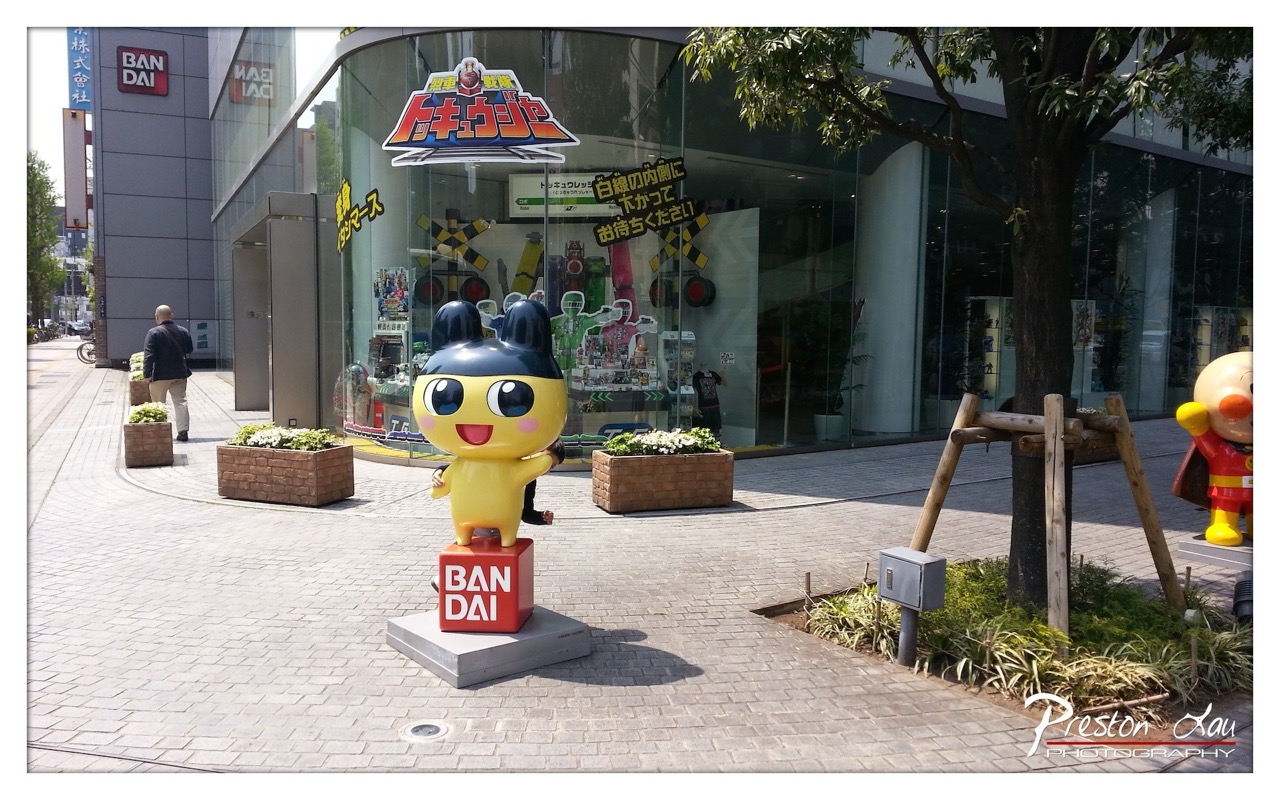

1. Overall Rating (0–10) — 7.0
This photograph captures the vibrant energy of a Japanese pop culture landmark, where the playful presence of a Tamagotchi statue contrasts with the sleek modernity of the Bandai building. The bright daylight and bold colors create an inviting, lively atmosphere, though the composition feels slightly scattered, with too many visual elements competing for attention. While the image effectively documents a cultural moment, its lack of editorial focus keeps it from feeling like a truly cohesive artistic statement.
2. Composition (0–10) — 6.0
The central Tamagotchi figure is well-placed but overshadowed by the surrounding elements—tree, planters, and the partial figure of another character. The leading lines of the sidewalk and building edges guide the eye, but the scene lacks a clear focal hierarchy.
3. Lighting (0–10) — 7.5
Bright, even daylight enhances the vividness of the colors and provides strong contrast, especially in the reflective glass of the building. The shadows are sharp and directional, adding depth without obscuring details.
4. Color & Tone (0–10) — 7.0
The palette is lively and saturated, with the yellow of the Tamagotchi and red of the Bandai block standing out against the neutral pavement and glass. The tonal range is well-balanced, though the overcast sky slightly tempers the overall vibrancy.
5. Creativity (0–10) — 7.5
The image successfully blends commercial branding with public art, capturing the whimsical intersection of technology and culture. The inclusion of the character’s gesture and the surrounding signage adds narrative depth.
6. Technical Quality (0–10) — 8.0
Sharp focus and clear detail across the frame, with excellent resolution in the textures of the pavement, foliage, and signage. The exposure is well-managed, with no areas of overexposure or loss of detail.
7. Emotional Impact (0–10) — 6.5
The image evokes a sense of nostalgia and childlike wonder, particularly for fans of the Tamagotchi franchise. While it captures a cheerful moment, the emotional resonance is limited by the image’s busy composition and lack of personal connection.
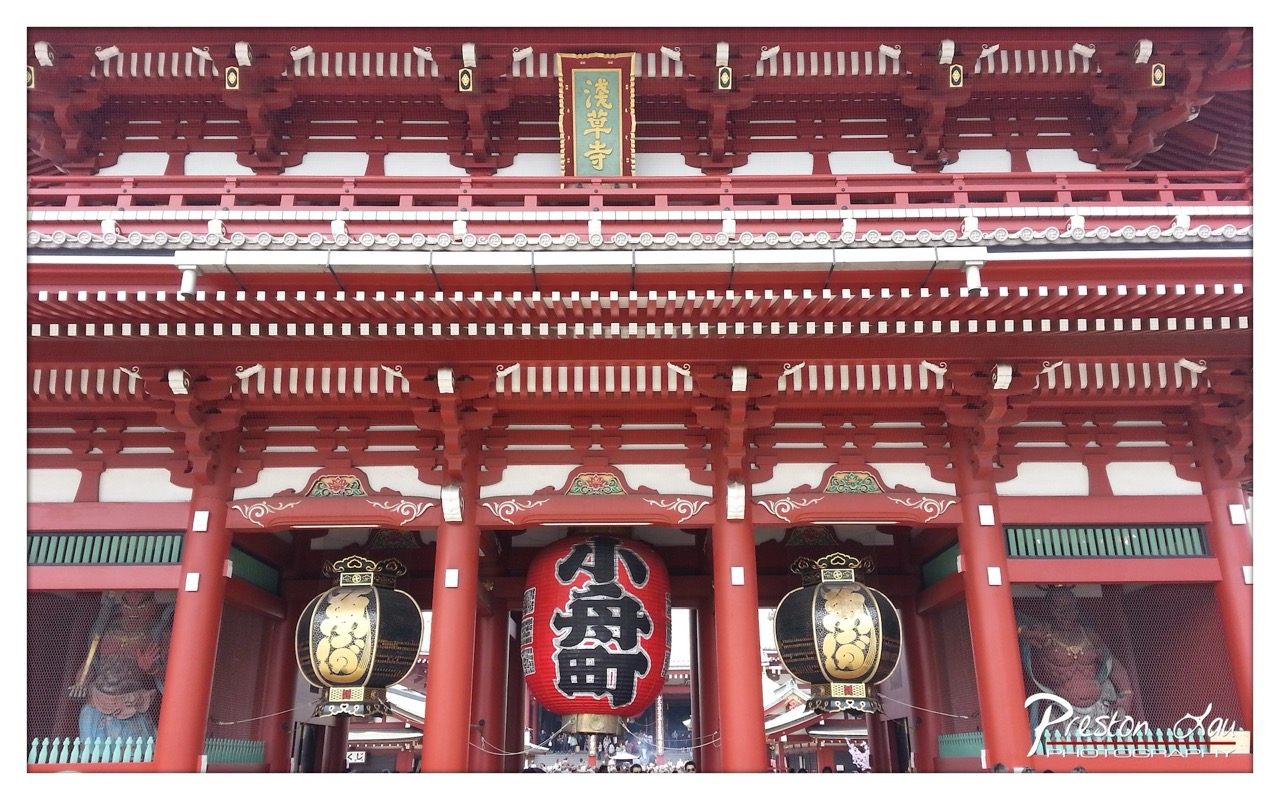

1. Overall Rating (0–10) — 7.5
This photograph captures the vibrant grandeur of Senso-ji Temple’s iconic red entrance, where traditional Japanese architecture meets cultural symbolism. The bold reds and symmetrical composition convey a sense of reverence and festivity, while the lanterns and signage add layers of meaning and visual rhythm. The image is strong in atmosphere and detail but slightly constrained by a lack of dynamic lighting and depth, keeping it from feeling truly immersive.
2. Composition (0–10) — 8.0
The symmetrical framing centers the main lantern and sign, creating a balanced and harmonious composition. The vertical lines of the pillars guide the eye upward, emphasizing the temple’s height and grandeur. The inclusion of the figures on either side adds subtle human context without disrupting the formal structure.
3. Lighting (0–10) — 6.0
The lighting is even and diffused, likely from an overcast day, which softens shadows and preserves detail in the red structure. However, this flatness reduces the sense of depth and drama, making the scene feel more like a straightforward documentation than a cinematic moment.
4. Color & Tone (0–10) — 8.0
The dominant red of the temple structure is rich and saturated, creating a powerful visual anchor. The contrast between the red, white, and black accents, along with the gold details on the lanterns, enhances the image’s traditional aesthetic. The color palette is cohesive and culturally resonant, though the overall tone leans slightly toward neutrality due to the lighting.
5. Creativity (0–10) — 7.0
The image successfully captures the essence of the location with a clear visual narrative rooted in Japanese tradition. The choice to include the large lantern and the temple sign adds cultural specificity, but the execution remains largely conventional, lacking a unique perspective or interpretive twist.
6. Technical Quality (0–10) — 8.5
The image is sharp and well-focused, with clear details in the architectural elements and text. The resolution is high, and the exposure is balanced, preserving texture in the wood and metal surfaces. The watermark is unobtrusive, indicating professional handling.
7. Emotional Impact (0–10) — 7.0
The photograph evokes a sense of awe and reverence, inviting the viewer to appreciate the cultural and spiritual significance of the temple. The vibrant colors and formal composition stir feelings of tradition and community, though the lack of human emotion or dynamic interaction tempers the emotional resonance.
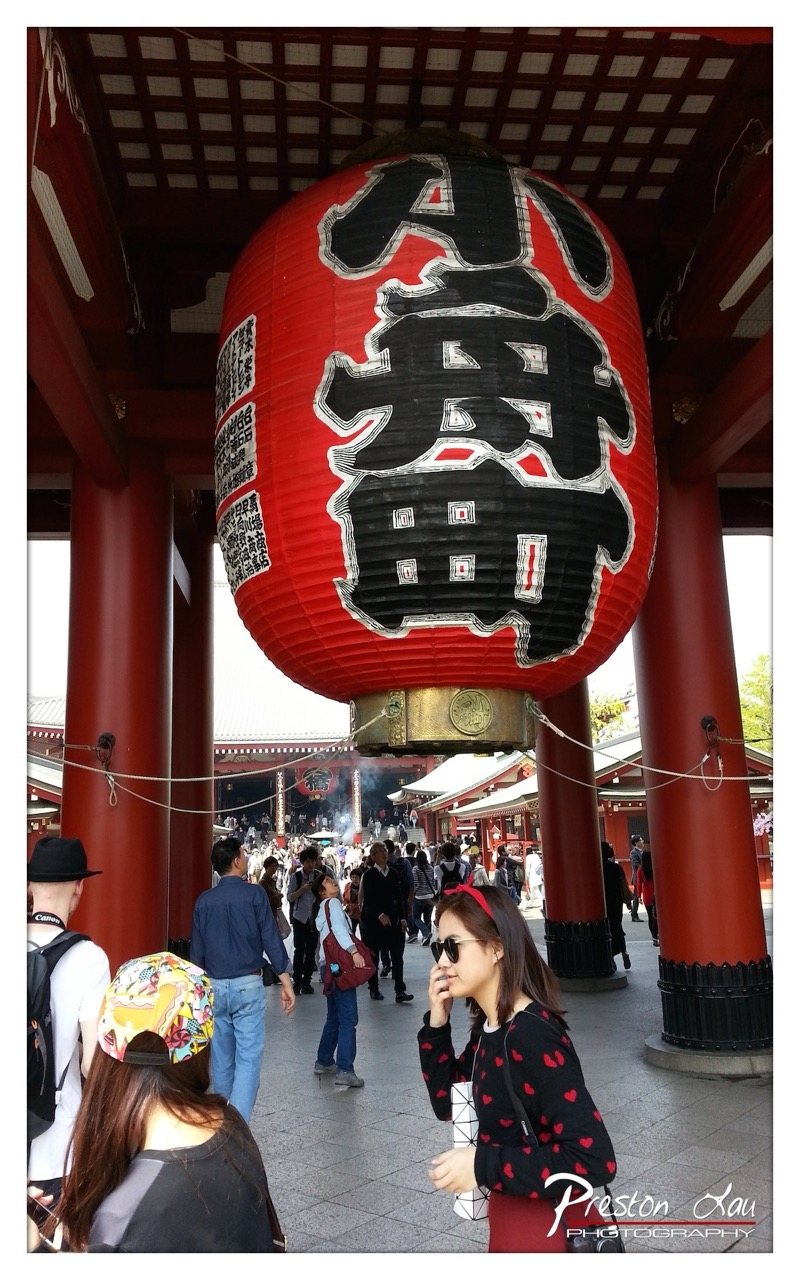

1. Overall Rating (0–10) — 7.0
This photograph captures the vibrant energy of a bustling Japanese temple entrance, where tradition and modern tourism converge. The massive red lantern, emblazoned with bold black calligraphy, commands attention and serves as a powerful cultural focal point. While the image is rich in cultural context and activity, the crowded composition and slightly cluttered foreground detract from its visual elegance, creating a sense of chaos rather than harmony.
2. Composition (0–10) — 6.5
The large lantern dominates the center, creating a strong focal point, but the inclusion of multiple figures in the foreground and mid-ground leads to visual clutter. The red pillars frame the scene effectively, but the composition lacks a clear narrative flow, with the eye drawn to various elements without a unified path.
3. Lighting (0–10) — 6.0
Natural daylight illuminates the scene evenly, allowing the lantern’s colors to pop. However, the flatness of the light—likely due to overcast skies or midday sun—diminishes the depth and shadows that could add dimension to the architecture and figures.
4. Color & Tone (0–10) — 7.5
The bold red of the lantern and pillars creates a striking contrast against the muted tones of the pavement and clothing. The black calligraphy and white background on the lantern add graphic intensity, while the overall palette remains balanced and culturally resonant.
5. Creativity (0–10) — 7.0
The photograph captures a moment of cultural immersion with a strong visual anchor—the lantern. The inclusion of tourists adds a layer of contemporary life to the sacred space, offering a narrative of coexistence between tradition and modernity. While not highly experimental, the image succeeds in documenting a dynamic cultural scene.
6. Technical Quality (0–10) — 7.0
The image is sharp and well-focused, with clear details in both the lantern and the people. The exposure is balanced, though there is a slight loss of detail in the brightest areas of the lantern and in the shadows beneath the structure.
7. Emotional Impact (0–10) — 6.5
The scene evokes a sense of awe and curiosity, drawing the viewer into the lively atmosphere of a sacred site. While the emotional resonance is strong in terms of cultural vibrancy, the sheer number of people and lack of personal connection in the frame keeps the emotional experience somewhat distant.
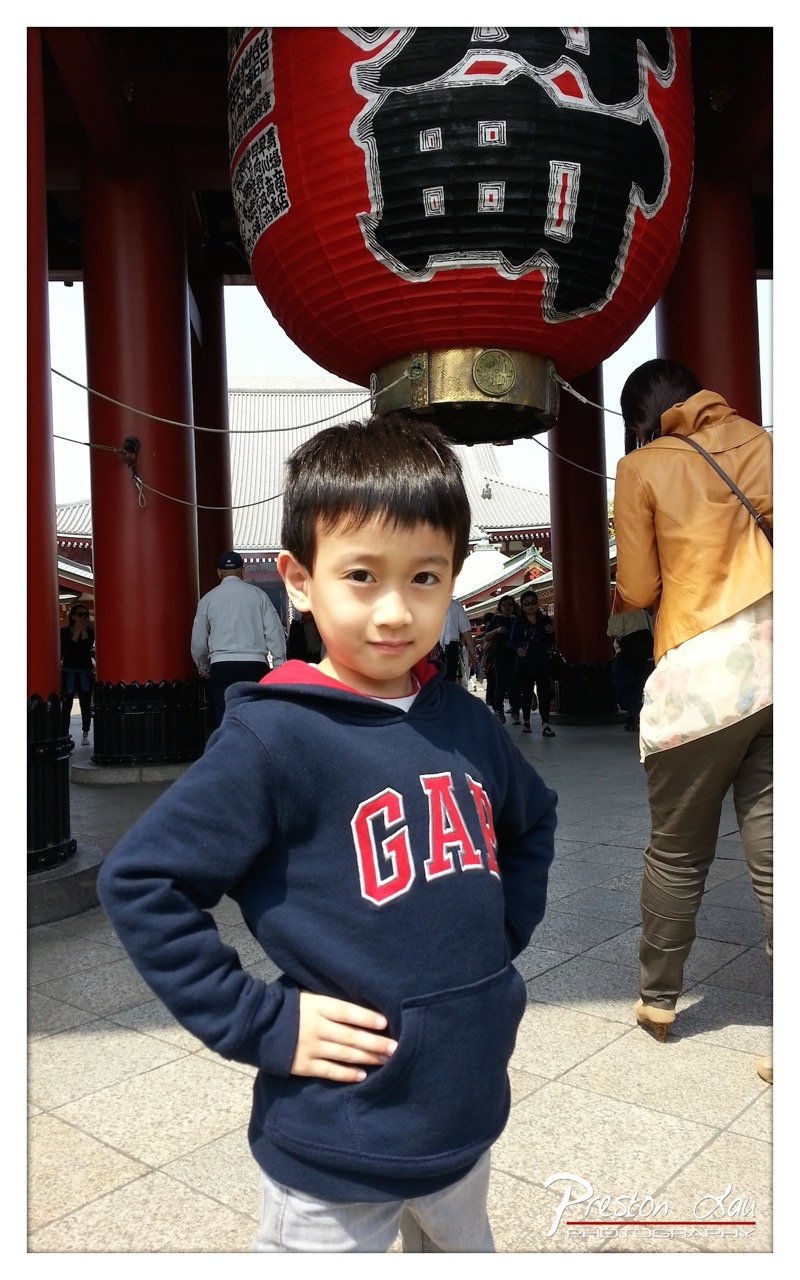

1. Overall Rating (0–10) — 7.0
This photograph captures a candid moment of youthful confidence against the vibrant backdrop of a traditional Japanese temple. The large red lantern and bold architectural elements provide cultural context and visual weight, while the boy’s pose and expression convey a quiet charm. The image succeeds as a personal memory, though the slightly awkward framing and overexposed background limit its artistic cohesion.
2. Composition (0–10) — 6.5
The boy is well-placed in the foreground, but the large lantern dominates the upper frame, creating visual imbalance. The background activity and off-center subject in the right add dynamism but also distract from the focal point.
3. Lighting (0–10) — 7.5
Natural daylight illuminates the scene clearly, with soft shadows indicating midday sun. The bright exposure enhances the vibrancy of the red lantern and the boy’s dark hoodie, though the background is slightly overexposed, washing out details.
4. Color & Tone (0–10) — 7.0
The red and black of the lantern contrast sharply with the muted tones of the pavement and background, creating visual energy. The color palette is balanced, with the navy blue and red of the hoodie complementing the dominant reds, though some colors appear slightly oversaturated.
5. Creativity (0–10) — 6.0
The image leverages cultural symbolism effectively, combining modern youth with traditional setting. While not conceptually groundbreaking, the juxtaposition adds narrative depth and emotional resonance.
6. Technical Quality (0–10) — 8.0
The image is sharp and well-focused on the boy, with clean detail in the fabric and lantern. The camera’s ability to capture fine textures and depth is strong, though slight overexposure in the background slightly compromises tonal range.
7. Emotional Impact (0–10) — 7.5
There’s a strong sense of innocence and pride in the boy’s expression, amplified by the cultural setting. The viewer is drawn into a personal moment, evoking warmth and nostalgia, particularly for those familiar with temple visits or childhood memories.
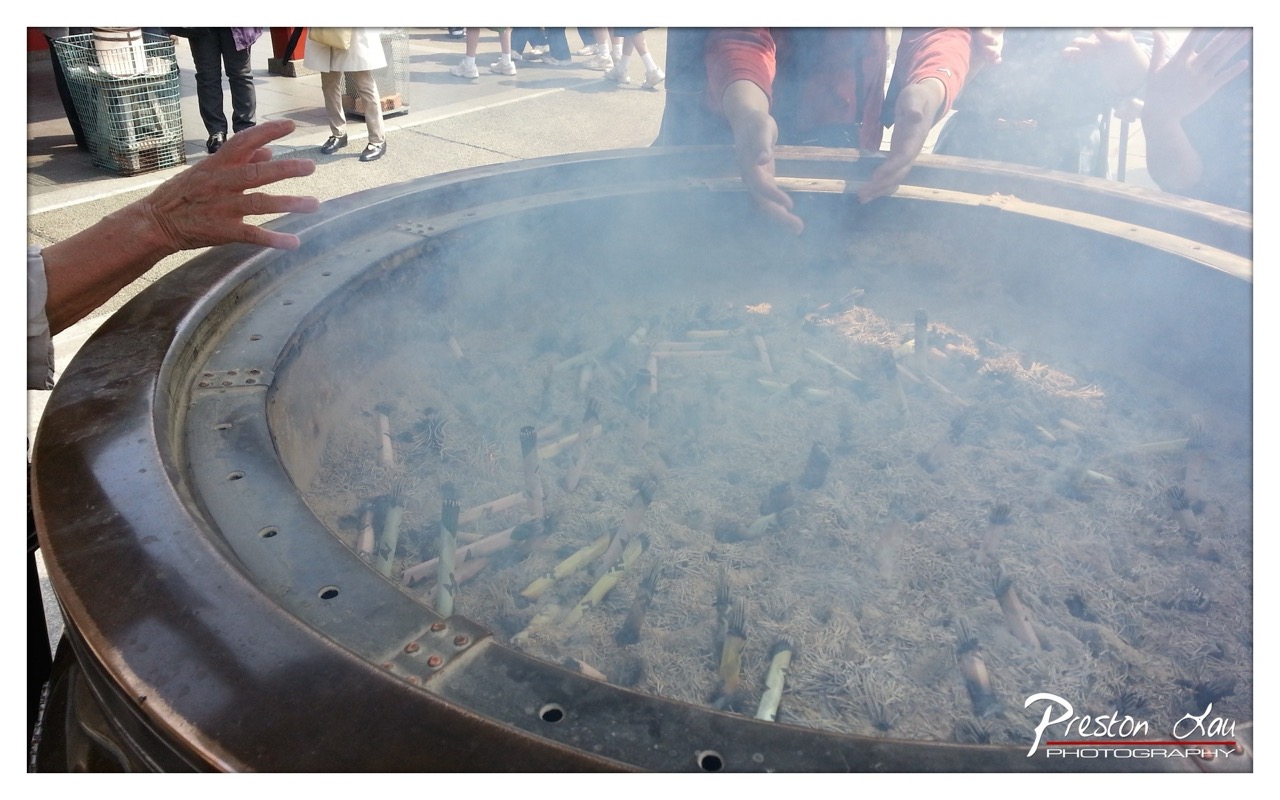

1. Overall Rating (0–10) — 7.0
This photograph captures a moment of spiritual ritual with palpable atmosphere, where smoke and gesture converge to evoke reverence and tradition. The composition draws the viewer into the scene through the intimate framing of hands reaching toward the incense-filled brazier, though the image’s authenticity is slightly undermined by a cluttered background and a lack of visual cohesion. The smoke adds a dreamlike quality, but the overall mood feels more documentary than poetic.
2. Composition (0–10) — 6.5
The circular frame of the brazier creates a natural focal point, drawing attention to the incense and the hands. However, the scattered background figures and the asymmetrical placement of the left hand disrupt visual harmony, creating a slightly chaotic feel.
3. Lighting (0–10) — 6.0
Natural daylight illuminates the scene evenly, but the flat quality of the light minimizes texture and depth. The smoke diffuses the light, softening edges and creating a hazy atmosphere, yet it also obscures finer details within the brazier.
4. Color & Tone (0–10) — 6.5
The palette is dominated by muted earth tones—browns, grays, and dull yellows—reflecting the natural materials and ash. While this creates a grounded, authentic feel, the lack of vibrancy limits the image’s visual impact and emotional resonance.
5. Creativity (0–10) — 7.0
The image captures a culturally rich moment with a strong sense of narrative. The inclusion of multiple hands suggests communal participation, elevating the photo beyond a simple snapshot into a storytelling device.
6. Technical Quality (0–10) — 7.5
The image is sharp and clear in focus, particularly around the brazier’s rim and the incense sticks. The depth of field is appropriate, keeping the central action in focus while softly blurring the background, though some noise is visible in the shadows.
7. Emotional Impact (0–10) — 7.0
There is a quiet solemnity in the gesture of hands reaching toward the smoke, suggesting prayer or offering. The viewer is invited to reflect on ritual and tradition, though the emotional pull is moderated by the image’s slightly detached and observational tone.
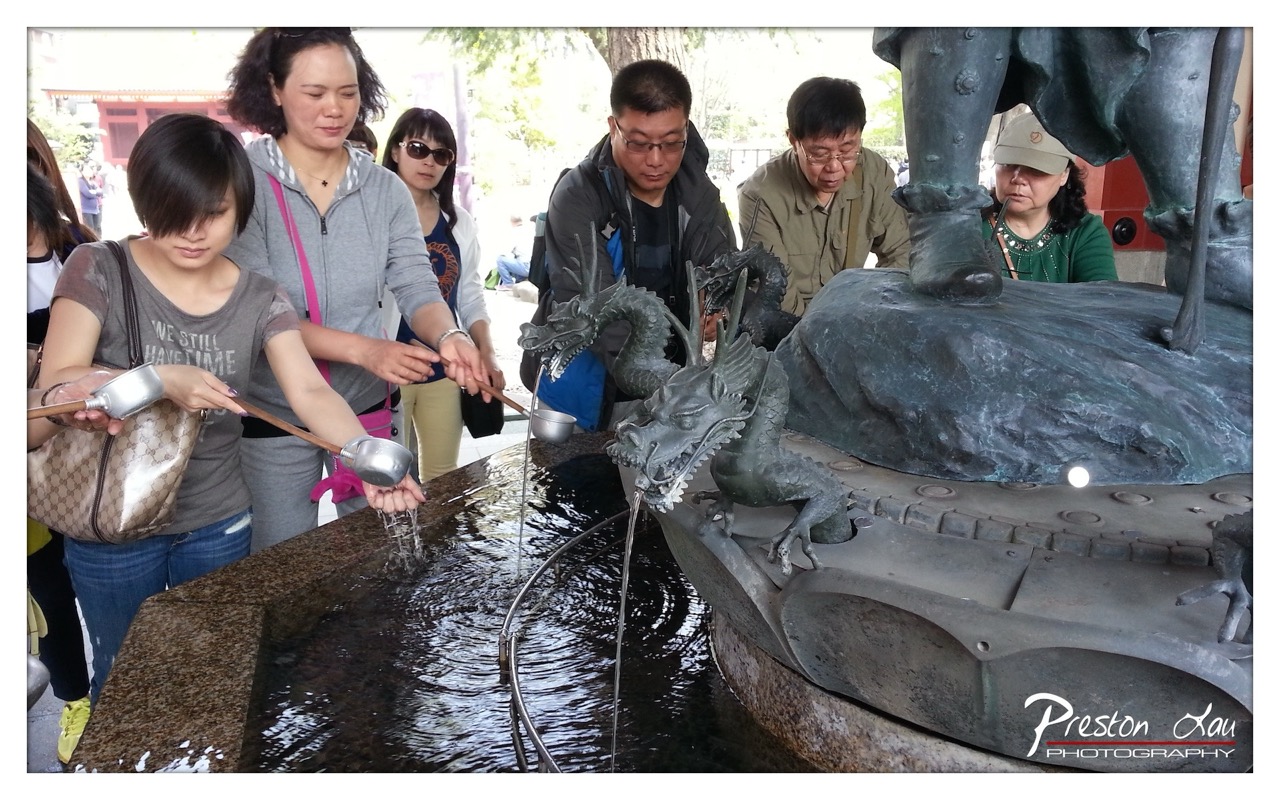

1. Overall Rating (0–10) — 7.0
This photograph captures a lively cultural moment at a traditional water fountain, where visitors engage in a ritualistic act of purification or blessing. The dynamic interaction between the people and the sculpted dragons creates a sense of shared experience and spiritual connection. While the scene is rich in narrative and cultural context, the composition feels slightly cluttered, and the lighting lacks the dramatic depth that could elevate the image into something more artistically resonant.
2. Composition (0–10) — 6.5
The frame is filled with multiple subjects and elements, creating a sense of depth and activity. The placement of the dragon fountain on the right balances the people on the left, but the overlapping figures and foreground distractions slightly disrupt the visual flow.
3. Lighting (0–10) — 6.0
Natural daylight illuminates the scene evenly, allowing clear visibility of details. However, the flat, overhead light minimizes shadows and depth, giving the image a documentary feel rather than a cinematic one.
4. Color & Tone (0–10) — 6.5
The palette is dominated by muted tones—grays, greens, and earthy browns—reflecting the metallic and stone elements. The colors are consistent and natural, but the lack of vibrancy reduces the image’s visual punch.
5. Creativity (0–10) — 7.5
The photograph successfully captures a unique cultural practice with authenticity and spontaneity. The inclusion of the dragon motif adds symbolic richness, and the candid nature of the moment enhances its storytelling potential.
6. Technical Quality (0–10) — 7.5
The image is sharp and well-focused, with clear details in both the subjects and the sculpture. The watermark is discreet, and the exposure is balanced, preserving detail in both highlights and shadows.
7. Emotional Impact (0–10) — 7.0
The scene evokes a sense of reverence and communal participation, drawing the viewer into a moment of quiet ritual. The expressions and actions of the individuals suggest genuine engagement, fostering a subtle emotional connection.
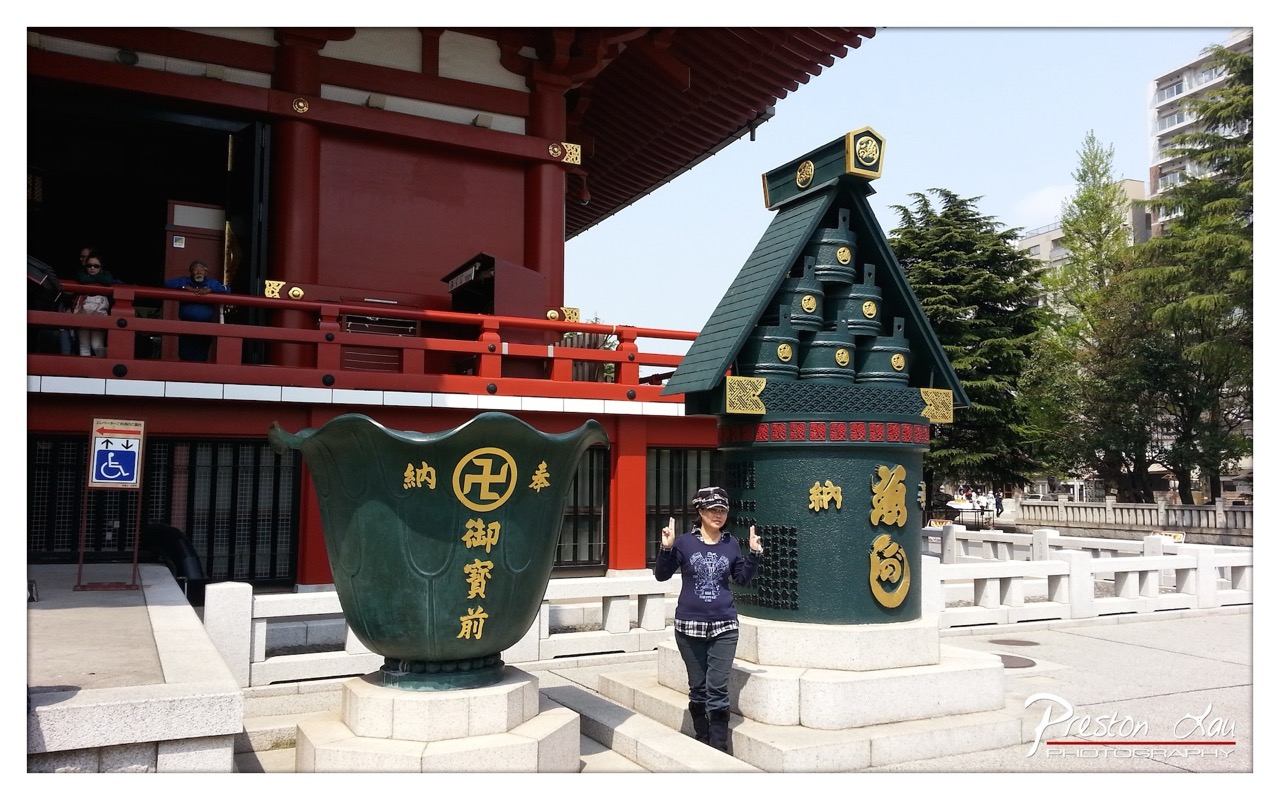

1. Overall Rating (0–10) — 7.0
This photograph captures a lively moment at a Japanese temple, blending cultural heritage with personal travel experience. The vibrant red of the temple contrasts beautifully with the deep green of the donation structures, creating a visually engaging scene. While the image feels slightly cluttered by the foreground elements and the tourist’s pose, it effectively conveys a sense of place and interaction, grounding the viewer in a real-world travel moment.
2. Composition (0–10) — 6.0
The subject is placed off-center, creating visual interest but also introducing imbalance. The large donation containers dominate the foreground, partially obscuring the temple’s architectural details and drawing attention away from the main structure.
3. Lighting (0–10) — 7.5
Natural daylight illuminates the scene evenly, highlighting the rich colors and textures of the temple and surrounding elements. The soft shadows suggest a midday sun, which enhances clarity without creating harsh contrasts.
4. Color & Tone (0–10) — 8.0
The bold red of the temple and the deep green of the donation vessels create a strong complementary contrast. The neutral tones of the stone and white railing balance the composition, while the sky provides a clean, light backdrop.
5. Creativity (0–10) — 6.5
The image captures a common tourist moment with a sense of authenticity, but the composition and subject’s pose feel somewhat staged. The cultural context adds depth, yet the visual narrative remains conventional rather than imaginative.
6. Technical Quality (0–10) — 8.0
The image is sharp and well-focused, with clean details in both the foreground and background. The exposure is well-balanced, and the resolution is high, preserving texture and clarity.
7. Emotional Impact (0–10) — 6.0
The photograph evokes a sense of exploration and cultural appreciation, but the subject’s direct engagement with the camera creates a slight disconnect, limiting the emotional depth. It feels more like a memory than a compelling story.


1. Overall Rating (0–10) — 7.5
This photograph captures the opulent stillness of a Japanese temple interior, where sacred ornamentation and spiritual reverence converge behind glass. The rich reds and golds create a visually arresting contrast, evoking both tradition and devotion. While the reflection on the glass slightly disrupts the clarity, the image succeeds in conveying the grandeur and solemnity of the space, inviting the viewer into a moment of quiet contemplation.
2. Composition (0–10) — 7.0
The symmetrical framing centers the altar, drawing the eye to the ornate golden structure. The vertical calligraphy on either side adds balance, though the slight tilt and reflection introduce a subtle asymmetry that slightly undermines the intended harmony.
3. Lighting (0–10) — 6.5
The interior lights cast a warm glow on the golden fixtures, enhancing their intricate details. However, the reflections on the glass and the overexposed ceiling light create distracting highlights, reducing the depth and mood of the scene.
4. Color & Tone (0–10) — 8.0
The rich reds of the temple frame contrast beautifully with the gilded interiors and the vibrant floral arrangements. The warm tones evoke a sense of reverence, while the deep blacks of the shadows add richness and dimension to the palette.
5. Creativity (0–10) — 7.5
The image presents a compelling juxtaposition of cultural and spiritual elements, using the glass barrier to frame the sacred space as both accessible and preserved. The inclusion of calligraphy and floral offerings adds narrative depth, suggesting ongoing devotion.
6. Technical Quality (0–10) — 7.0
The image is sharp and detailed, particularly in the intricate goldwork and floral arrangements. However, the reflections on the glass and the visible watermark slightly detract from the overall clarity and professionalism.
7. Emotional Impact (0–10) — 8.0
There is a palpable sense of peace and reverence, enhanced by the soft lighting and the careful arrangement of offerings. The viewer is drawn into the quiet dignity of the space, evoking a feeling of awe and respect for tradition.
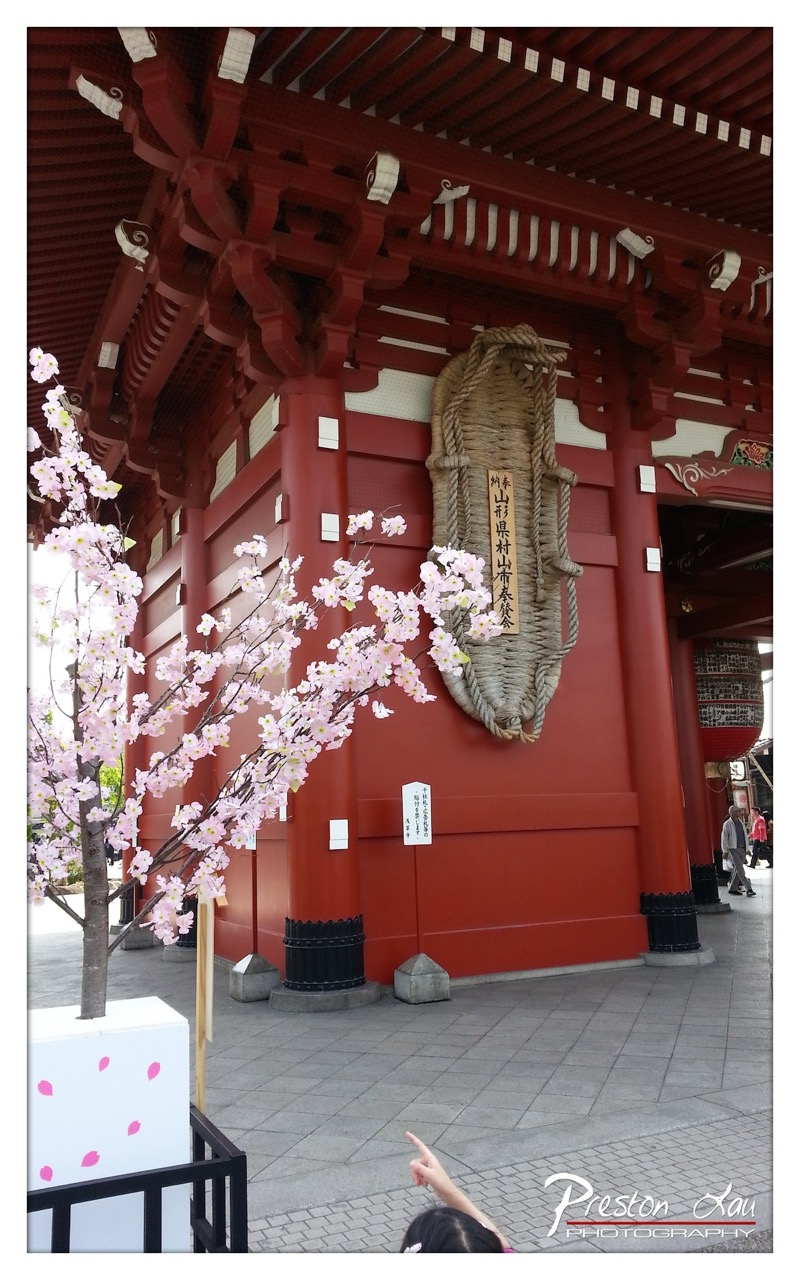

1. Overall Rating (0–10) — 7.0
This photograph captures the vibrant intersection of tradition and seasonal beauty at a Japanese temple, where the bold red architecture and delicate cherry blossoms create a striking visual contrast. The inclusion of a child’s pointing hand adds a sense of wonder and scale, grounding the scene in human experience. While the composition is strong and the colors rich, the framing feels slightly cluttered, and the lighting, though bright, lacks subtlety, slightly diminishing the image’s atmospheric depth.
2. Composition (0–10) — 6.5
The diagonal line of the cherry blossom branches draws the eye across the frame, balancing the dominant red structure. However, the inclusion of the lower edge of the child’s head and the white planter slightly disrupts the visual harmony, and the wide-angle perspective introduces some distortion at the edges.
3. Lighting (0–10) — 6.0
Natural daylight provides even illumination, enhancing the vivid red of the temple and the soft pink of the blossoms. The overhead light creates minimal shadows, which helps maintain clarity but reduces the sense of depth and mood that directional lighting might have provided.
4. Color & Tone (0–10) — 7.5
The palette is rich and harmonious, with the deep vermilion of the temple contrasting beautifully against the soft pink blossoms and the neutral gray pavement. The color temperature feels natural, enhancing the authenticity of the scene, though the overall vibrancy could be slightly more balanced to avoid overwhelming the eye.
5. Creativity (0–10) — 7.0
The image successfully blends cultural elements with a personal, human touch through the child’s gesture. The juxtaposition of ancient architecture and fleeting springtime beauty offers a narrative that feels both grounded and poetic, elevating it beyond a simple travel snapshot.
6. Technical Quality (0–10) — 7.5
The image is sharp and well-focused, particularly on the central elements of the temple and the rope decoration. The depth of field is sufficient to keep the main subject clear while softly blurring the background, and the exposure is well-balanced, with no significant over- or underexposed areas.
7. Emotional Impact (0–10) — 7.0
There is a strong sense of serenity and reverence evoked by the temple setting, enhanced by the seasonal blossoms and the quiet presence of the child. The viewer is invited into a moment of cultural appreciation and wonder, creating a warm and contemplative emotional resonance.
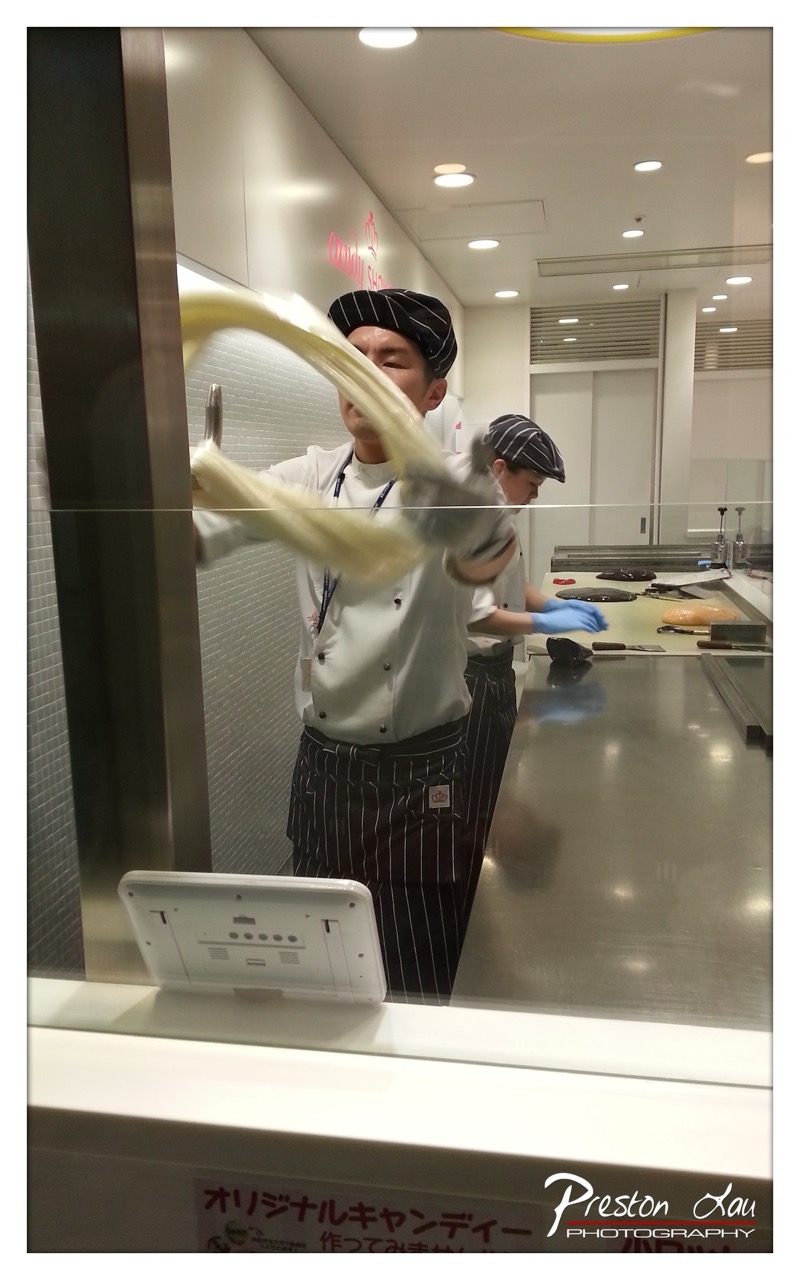

1. Overall Rating (0–10) — 6.8
This photograph captures the dynamic energy of a candy-making demonstration, where motion and craftsmanship converge behind glass. The blur of the stretched candy highlights the artisan’s skill and the fluidity of the process, while the clean, bright kitchen environment grounds the scene in authenticity. While the framing feels slightly obstructed by the glass and foreground elements, the image successfully conveys the sensory appeal of handmade sweets and the dedication of the craft.
2. Composition (0–10) — 6.0
The subject is centered and framed by the glass barrier, creating a sense of separation between viewer and maker. The diagonal movement of the candy adds dynamism, but the foreground device and text distract from the focal action.
3. Lighting (0–10) — 7.0
Bright, even overhead lighting illuminates the scene clearly, emphasizing the cleanliness of the kitchen and the sheen of the sugar. The reflections on the glass slightly reduce clarity but do not detract significantly from visibility.
4. Color & Tone (0–10) — 6.5
The palette is dominated by neutral whites and grays, punctuated by the warm, translucent yellow of the candy and the dark stripes of the chefs’ uniforms. The contrast between the soft candy and the industrial setting creates visual interest, though the overall tone remains somewhat sterile.
5. Creativity (0–10) — 7.0
The use of motion blur to capture the candy’s stretch is a strong creative choice, effectively conveying movement and process. The perspective—viewing through glass—adds narrative depth, suggesting both accessibility and separation.
6. Technical Quality (0–10) — 7.5
The image is sharp in focus where intended, particularly on the chef’s face and hands. The motion blur is controlled and intentional, and the exposure is well-managed despite the reflective surfaces.
7. Emotional Impact (0–10) — 6.5
The photograph evokes a sense of curiosity and delight, inviting the viewer into a world of skilled craftsmanship. The quiet intensity of the chef’s concentration and the tactile quality of the candy create a subtle emotional resonance, though the viewer’s connection is moderated by the physical barrier of the glass.
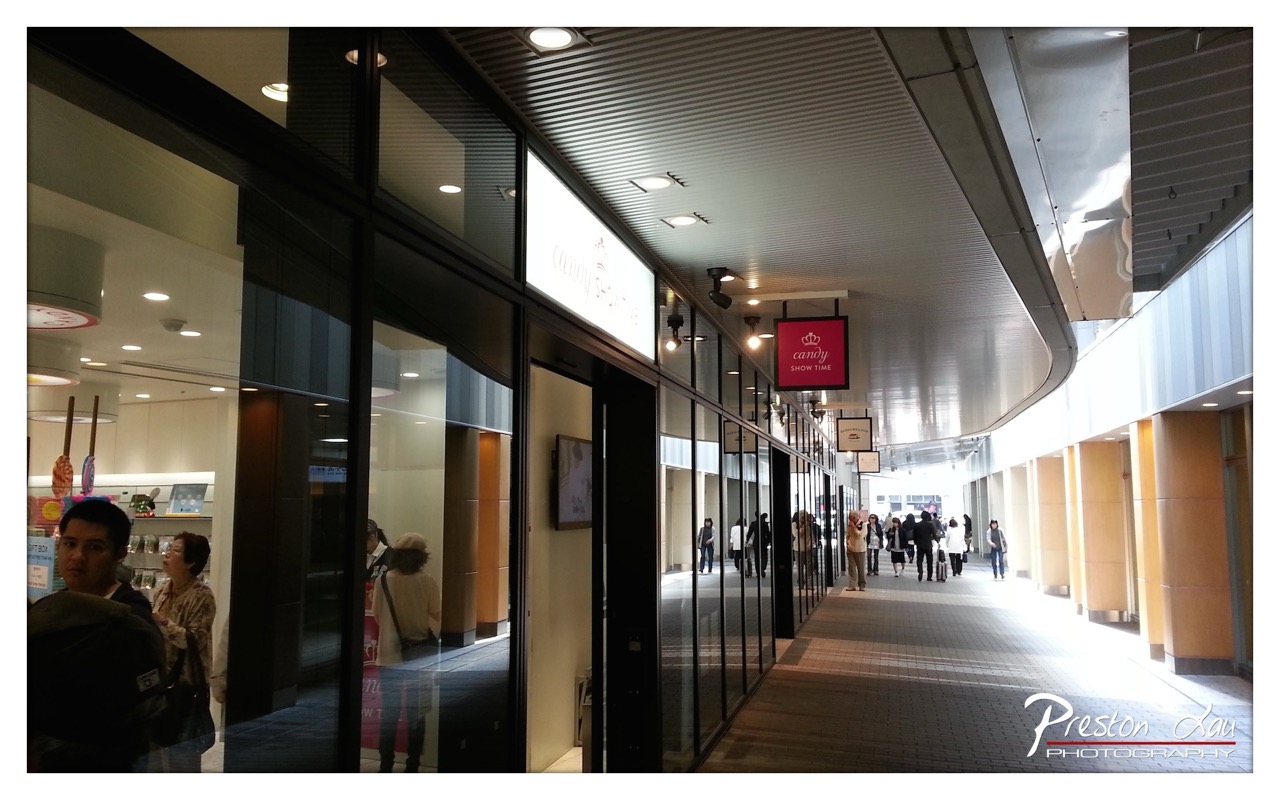

1. Overall Rating (0–10) — 6.0
This photograph captures the quiet hum of a modern shopping corridor, where architecture and movement intersect in a subtle rhythm. The long perspective draws the eye down the passage, evoking a sense of journey and daily life, though the scene feels slightly sterile and detached. While the composition is strong and the lighting provides a sense of clarity, the image lacks emotional depth, offering more a snapshot of place than a moment of human connection.
2. Composition (0–10) — 7.0
The leading lines of the corridor create a strong sense of depth, with the perspective pulling the viewer forward. The balance between the glass storefronts on the left and the open walkway on the right provides visual harmony, though the placement of the foreground figures slightly disrupts the symmetry.
3. Lighting (0–10) — 6.5
The overhead lighting is functional and even, casting a cool, clinical glow that enhances the modern aesthetic. Natural light at the far end softens the scene, creating a gentle contrast with the interior illumination and adding subtle warmth to the background.
4. Color & Tone (0–10) — 6.0
The palette is dominated by neutral grays, whites, and blacks, punctuated by the red sign that serves as a visual anchor. While the color temperature is consistent, the lack of vibrancy limits the image’s emotional resonance, giving it a slightly muted, documentary feel.
5. Creativity (0–10) — 6.5
The photograph leverages perspective and repetition to create visual interest, capturing a moment of urban flow with quiet intention. The use of reflections in the glass adds layers, suggesting a layered reality—both physical and psychological—though the concept remains grounded in observation rather than bold interpretation.
6. Technical Quality (0–10) — 7.5
The image is sharp and well-exposed, with clear detail in both the foreground and background. The focus is consistent, and the digital clarity allows for fine texture in the ceiling and floor, indicating strong technical execution.
7. Emotional Impact (0–10) — 5.5
While the image conveys a sense of place and movement, it remains emotionally distant. The lack of strong human expression or narrative context keeps the viewer as an observer rather than a participant, limiting the emotional pull of the scene.
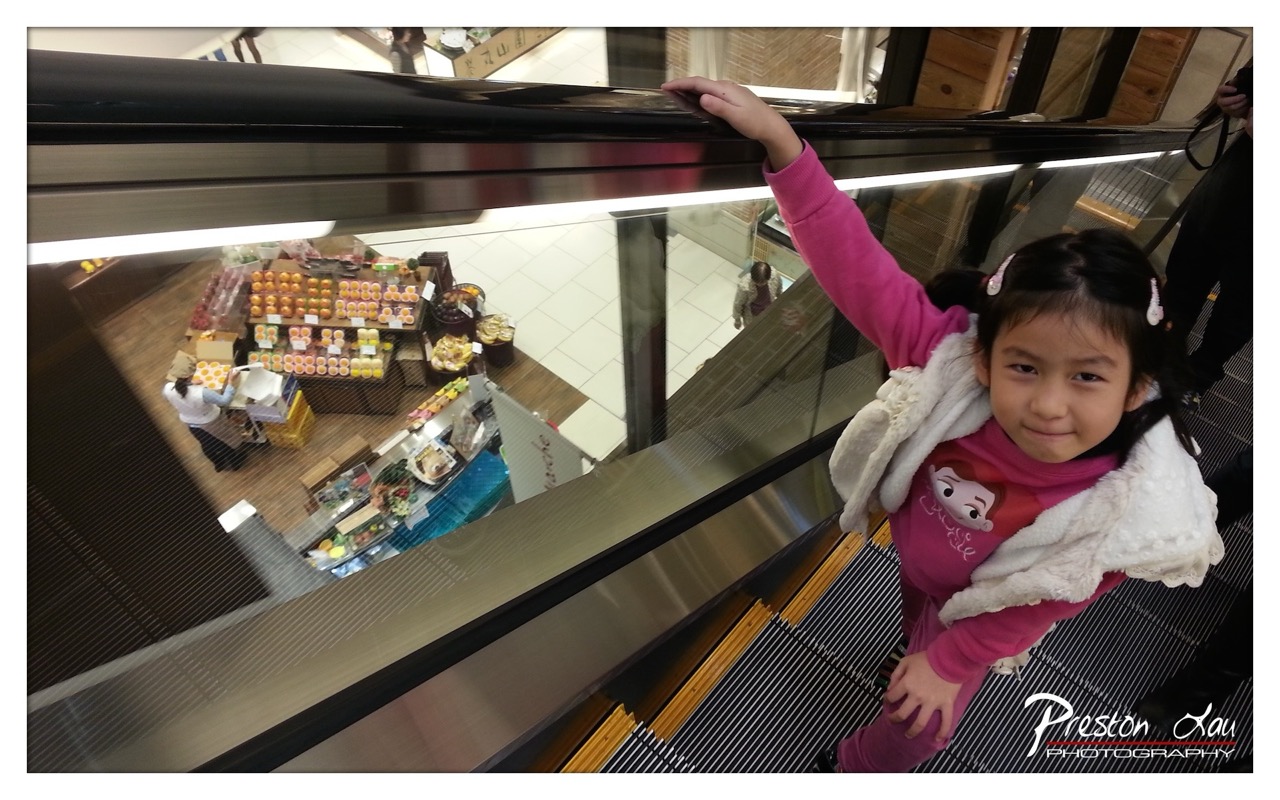

1. Overall Rating (0–10) — 7.0
This photograph captures a candid, joyful moment of a young girl on an escalator, her expression radiating quiet confidence and delight. The high-angle perspective creates a sense of intimacy and motion, drawing the viewer into the bustling yet orderly environment of a shopping mall. While the image is rich in narrative potential, the composition and lighting feel slightly constrained by the setting, limiting its emotional depth and visual impact.
2. Composition (0–10) — 6.5
The diagonal lines of the escalator rail and steps create a dynamic visual path, guiding the eye toward the girl. However, the framing is slightly off-center and the background appears cluttered, with the fruit stand and other shoppers competing for attention. A tighter crop or adjusted angle could have emphasized the subject more effectively.
3. Lighting (0–10) — 6.0
The scene is illuminated by typical indoor fluorescent lighting, which is functional but flat and unflattering. The light creates a cool, neutral tone that lacks warmth and depth, contributing to a slightly sterile atmosphere. Shadows are minimal, which reduces the sense of dimensionality.
4. Color & Tone (0–10) — 6.5
The dominant pink of the girl’s outfit provides a vibrant contrast to the muted grays and metallic tones of the escalator and surroundings. While the color palette is balanced, it lacks richness and saturation, making the image feel somewhat muted despite the bright clothing.
5. Creativity (0–10) — 7.0
The photographer captures a spontaneous, genuine moment with a strong sense of place. The high-angle perspective and the girl’s direct gaze add narrative depth and a sense of connection. The composition reflects a candid, observational style that feels authentic, though not overtly stylized.
6. Technical Quality (0–10) — 7.5
The image is sharp and clear, with good focus on the subject. The digital resolution and detail are strong, particularly in the texture of the girl’s clothing and the escalator’s surface. The watermark is subtle and does not detract from the image.
7. Emotional Impact (0–10) — 7.5
The girl’s gentle smile and engaged expression evoke a sense of warmth and innocence. The viewer is drawn into the moment, imagining the child’s excitement as she rides the escalator. The scene feels personal and relatable, creating a quiet emotional resonance despite the public setting.
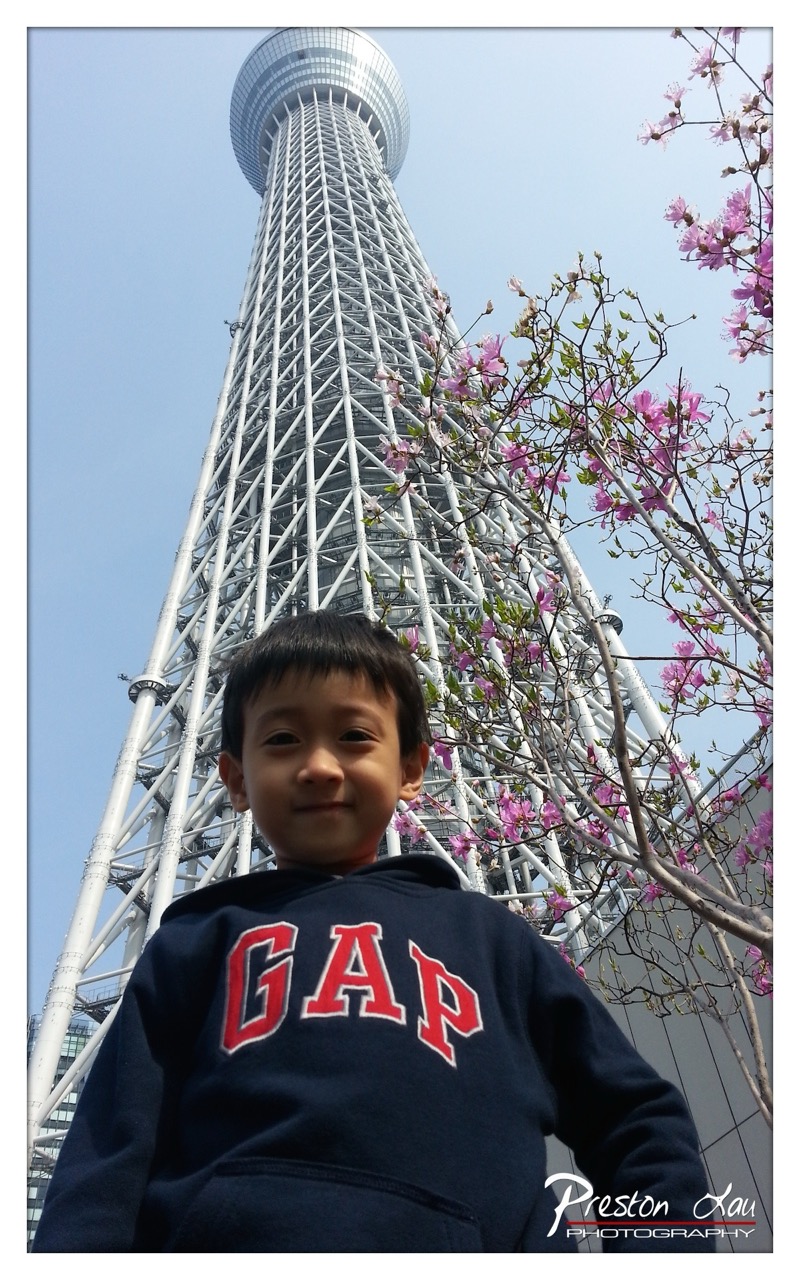

1. Overall Rating (0–10) — 7.0
This photograph captures a joyful moment of a child in front of the Tokyo Skytree, blending human scale with architectural grandeur. The low-angle perspective emphasizes the tower’s imposing height, while the blooming cherry blossoms add a touch of seasonal beauty and cultural resonance. The image feels personal and celebratory, though the composition’s busy framing and slightly awkward focus on the child’s face detract from its overall cohesion.
2. Composition (0–10) — 6.5
The low-angle shot creates a dramatic sense of scale, with the tower rising diagonally behind the child. However, the overhang of branches and blossoms on the right slightly distracts from the subject, and the child’s placement, while central, feels slightly off-balance due to the tilted framing.
3. Lighting (0–10) — 7.5
Natural daylight provides even illumination, enhancing the crispness of the tower’s steel structure and the soft texture of the blossoms. The bright, slightly cool light contributes to a clean, airy atmosphere, though some overexposure in the sky reduces tonal depth.
4. Color & Tone (0–10) — 7.0
The contrast between the deep navy of the hoodie, the vibrant pink blossoms, and the cool white of the tower creates a visually engaging palette. The colors feel authentic and harmonious, with a light, springtime tone that reinforces the mood of renewal and joy.
5. Creativity (0–10) — 7.5
The combination of a child, a modern landmark, and traditional cherry blossoms offers a thoughtful juxtaposition of youth, progress, and nature. The choice of a low-angle view adds narrative weight, transforming a simple souvenir shot into a layered visual story.
6. Technical Quality (0–10) — 7.0
The image is sharp and well-focused on the child, with clean detail in the tower’s lattice structure. The exposure is mostly balanced, though the sky shows slight overexposure. The watermark is subtle and does not detract from the image.
7. Emotional Impact (0–10) — 7.5
There’s an immediate sense of warmth and happiness conveyed through the child’s gentle smile and the seasonal beauty of the blossoms. The photo evokes nostalgia and wonder, capturing a fleeting, personal moment within a globally recognized setting.
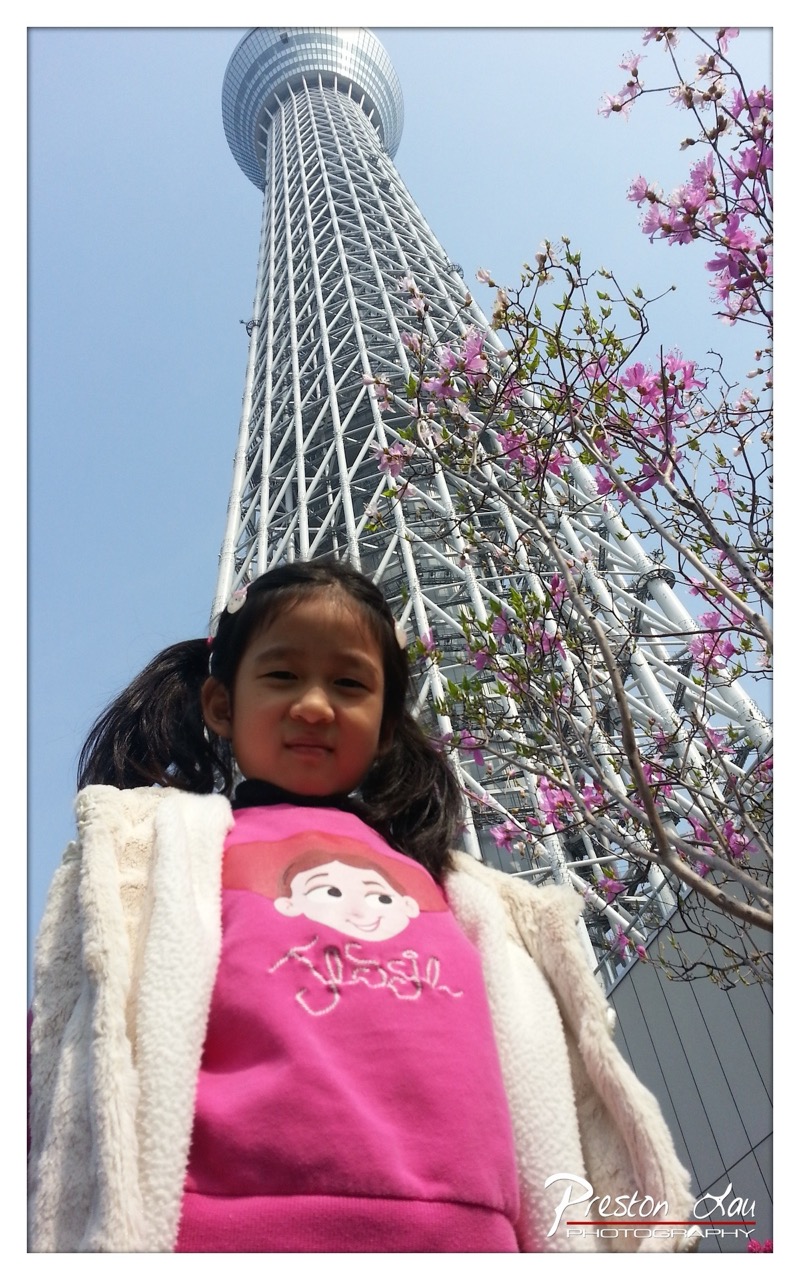

1. Overall Rating (0–10) — 7.5
This photograph captures a joyful, intimate moment of childhood against the grand backdrop of a towering landmark, creating a compelling contrast between innocence and modernity. The low-angle perspective emphasizes the scale of the structure while keeping the child as the emotional anchor, and the soft pink blossoms add a touch of seasonal warmth. While the image is strong in composition and mood, the slightly overexposed sky and flat lighting hold it back from true artistic distinction.
2. Composition (0–10) — 8.0
The low-angle framing draws the eye upward along the tower’s diagonal lines, creating a sense of height and dynamism. The child is centered and well-placed, with the flowering branches framing the right side and adding depth, though the left side feels slightly unbalanced.
3. Lighting (0–10) — 6.5
Natural daylight provides even illumination, but the sky is slightly overexposed, losing detail in the clouds. The light is flat and diffused, lacking the warmth or shadows that would enhance dimensionality.
4. Color & Tone (0–10) — 7.0
The vibrant pink of the child’s shirt and the blossoms creates a cheerful, harmonious contrast against the cool blue sky and white tower. The color palette feels balanced and springlike, though the overall tone is slightly washed out.
5. Creativity (0–10) — 7.5
The juxtaposition of a young girl with a towering urban landmark offers a narrative of wonder and perspective. The inclusion of the blossoms adds a seasonal, poetic touch, making the image feel both personal and timeless.
6. Technical Quality (0–10) — 7.5
The focus is sharp on the child, with good detail in the facial features and clothing. The image is clean and free of noise, though minor overexposure in the sky reduces dynamic range.
7. Emotional Impact (0–10) — 8.0
The image evokes a sense of wonder, joy, and fleeting childhood memory. The child’s gentle expression and the surrounding beauty create an emotional resonance that feels genuine and touching.
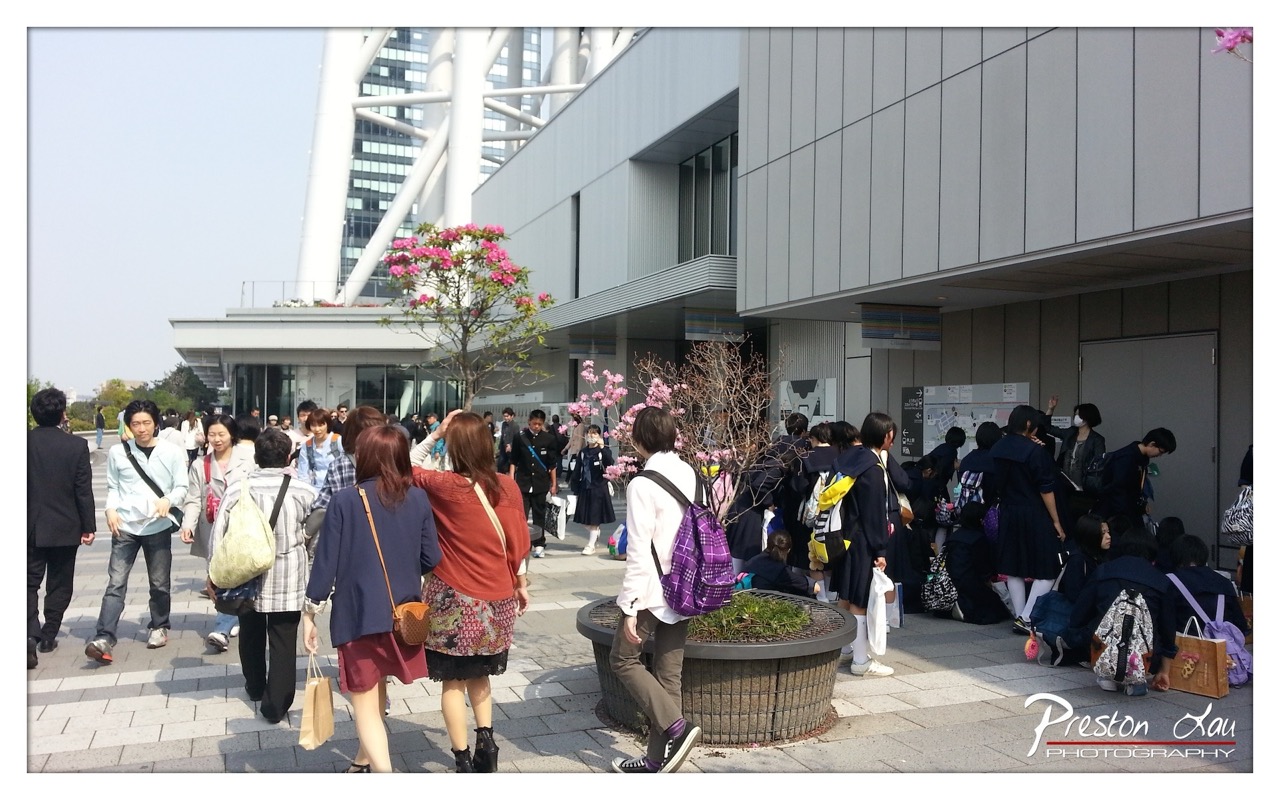

1. Overall Rating (0–10) — 6.8
This photograph captures the vibrant energy of a bustling urban plaza, where modern architecture meets everyday life. The dynamic crowd, framed by blooming sakura and sleek steel structures, conveys a sense of movement and cultural rhythm. While the scene is rich in detail and context, the image's potential is slightly dampened by a lack of visual focus, leaving the viewer’s eye scattered across the frame.
2. Composition (0–10) — 6.0
The wide-angle perspective creates a sense of immersion but sacrifices compositional balance. The diagonal flow of the crowd and the placement of the planter disrupt visual harmony, while the large building on the right dominates the frame, creating an uneven weight distribution.
3. Lighting (0–10) — 6.5
Bright, even daylight illuminates the scene clearly, enhancing detail and texture across the crowd and architecture. However, the flatness of the light minimizes shadows and depth, giving the image a slightly documentary feel rather than a cinematic one.
4. Color & Tone (0–10) — 7.0
The palette is harmonious, with the soft pinks of the cherry blossoms offering a striking contrast against the cool grays of the modern building. The natural tones feel authentic, though the colors lack saturation, slightly muting the vibrancy of the scene.
5. Creativity (0–10) — 6.5
The photograph successfully documents a moment in time, blending urban life with seasonal beauty. While the subject is familiar, the inclusion of the blossoms and the architectural backdrop provides a subtle narrative of renewal and modernity—though it stops short of true artistic innovation.
6. Technical Quality (0–10) — 7.5
The image is sharp and well-exposed, with clean details visible in both the background and foreground. The focus is consistent across the frame, and there are no noticeable technical flaws, making it a strong technical capture.
7. Emotional Impact (0–10) — 6.0
The scene evokes a sense of everyday life in a bustling city, with quiet moments of human connection amid the rush. While the emotional resonance is present, it remains restrained—more observational than deeply moving.
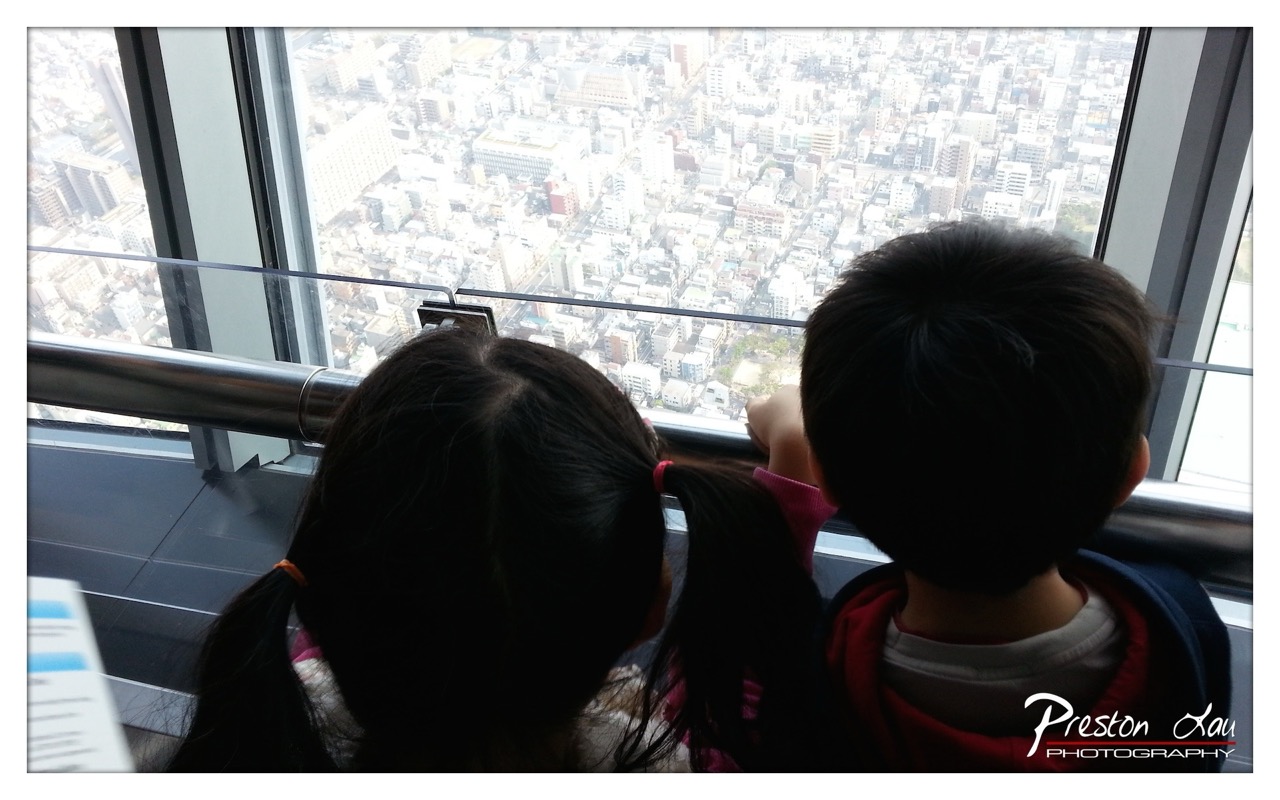

1. Overall Rating (0–10) — 7.0
This photograph captures a quiet, intimate moment of two children gazing out over a sprawling urban landscape, evoking a sense of wonder and discovery. The composition draws the viewer into the scene, inviting them to share in the children’s awe, while the city below serves as a vast, textured backdrop. The image is emotionally resonant but slightly restrained by its technical execution, particularly in lighting and contrast.
2. Composition (0–10) — 7.5
The over-the-shoulder framing effectively places the viewer in the scene, creating a sense of shared experience. The children are positioned slightly off-center, leading the eye toward the expansive cityscape, which dominates the frame and provides context and scale. The railing adds a subtle structural line that guides the gaze outward.
3. Lighting (0–10) — 6.0
Natural daylight from the large window illuminates the city, but the children are backlit, rendering them as dark silhouettes. While this creates a dramatic contrast, it obscures facial details and diminishes the emotional connection with the subjects. The lighting enhances the mood of contemplation but at the cost of clarity.
4. Color & Tone (0–10) — 6.5
The palette is dominated by cool grays and whites from the city and the interior, with subtle hints of color in the children’s clothing—pink and red—that provide visual anchors. The overall tone is subdued and slightly flat, lacking vibrancy, though the contrast between the dark silhouettes and bright background adds depth.
5. Creativity (0–10) — 7.0
The image is conceptually strong, capturing a universal moment of childhood curiosity and urban exploration. The choice to photograph from behind the children adds narrative depth, suggesting a story of discovery. While the approach is familiar, it is executed with sincerity and emotional weight.
6. Technical Quality (0–10) — 7.0
The image is sharp and well-focused, particularly on the cityscape, with clean details in the distant buildings. The photographer maintains a good level of control, though the silhouetting of the subjects is a result of exposure choices that sacrifice detail for mood.
7. Emotional Impact (0–10) — 7.5
The photograph resonates with a quiet, reflective emotion—childlike wonder, perhaps a touch of awe or even smallness in the face of the immense city. The viewer is drawn into the moment, imagining the thoughts and feelings of the children as they take in the view, making it a poignant and relatable image.
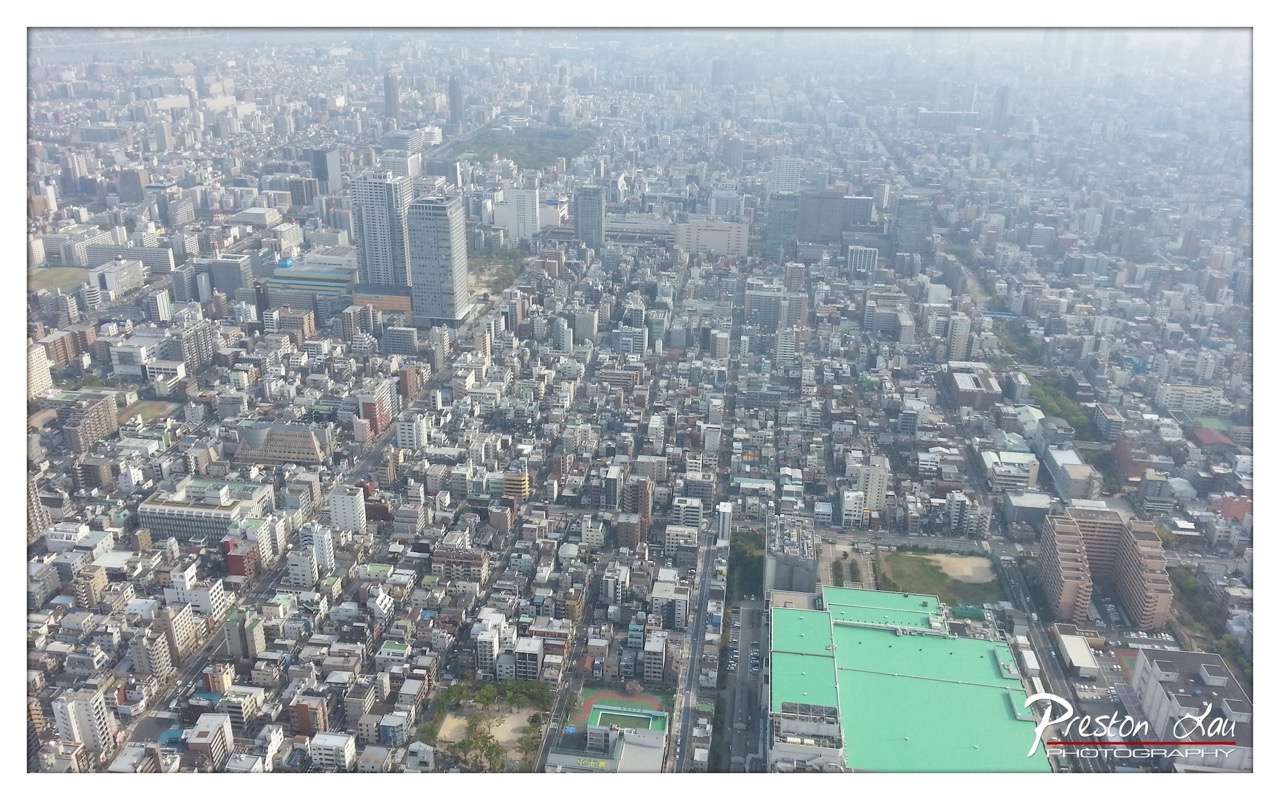

1. Overall Rating (0–10) — 6.0
This aerial view captures the dense, sprawling urban fabric of a major Japanese city, conveying both the energy and the overwhelming scale of modern metropolitan life. The hazy atmosphere lends a dreamlike quality, softening the sharp edges of the cityscape and evoking a sense of distance and contemplation. While the image effectively communicates the vastness of the urban environment, it lacks a strong focal point, and the hazy conditions slightly diminish the clarity and impact of the scene.
2. Composition (0–10) — 6.0
The wide-angle perspective captures a broad expanse, but the lack of a clear focal point or leading lines makes the composition feel scattered. The diagonal flow of roads offers some structure, but the sheer density of buildings overwhelms the eye, resulting in a visually busy but unbalanced frame.
3. Lighting (0–10) — 5.5
The lighting is diffused by haze, creating a soft, even illumination across the scene. While this avoids harsh shadows and highlights, it also flattens the image’s depth and diminishes contrast, resulting in a muted and somewhat indistinct atmosphere.
4. Color & Tone (0–10) — 5.0
The color palette is dominated by neutral grays and beiges, punctuated only by the bright green rooftops in the lower right. This limited vibrancy, combined with the hazy atmosphere, gives the image a subdued and slightly monotonous tone, though the green accents offer a subtle visual contrast.
5. Creativity (0–10) — 6.5
The elevated vantage point and hazy conditions create a contemplative mood, transforming a typical cityscape into something more atmospheric. The choice to emphasize scale over detail is effective, though the image remains largely observational rather than artistically expressive.
6. Technical Quality (0–10) — 7.0
The image is sharp and clear in its details, with good resolution and minimal noise. The framing is well-executed, capturing a wide view with consistent focus throughout the scene.
7. Emotional Impact (0–10) — 5.5
The photograph evokes a sense of awe at the scale of urban life, but the hazy conditions and lack of human presence keep the viewer at a distance. It feels more like a document of a city than an emotionally resonant portrait, offering observation rather than connection.
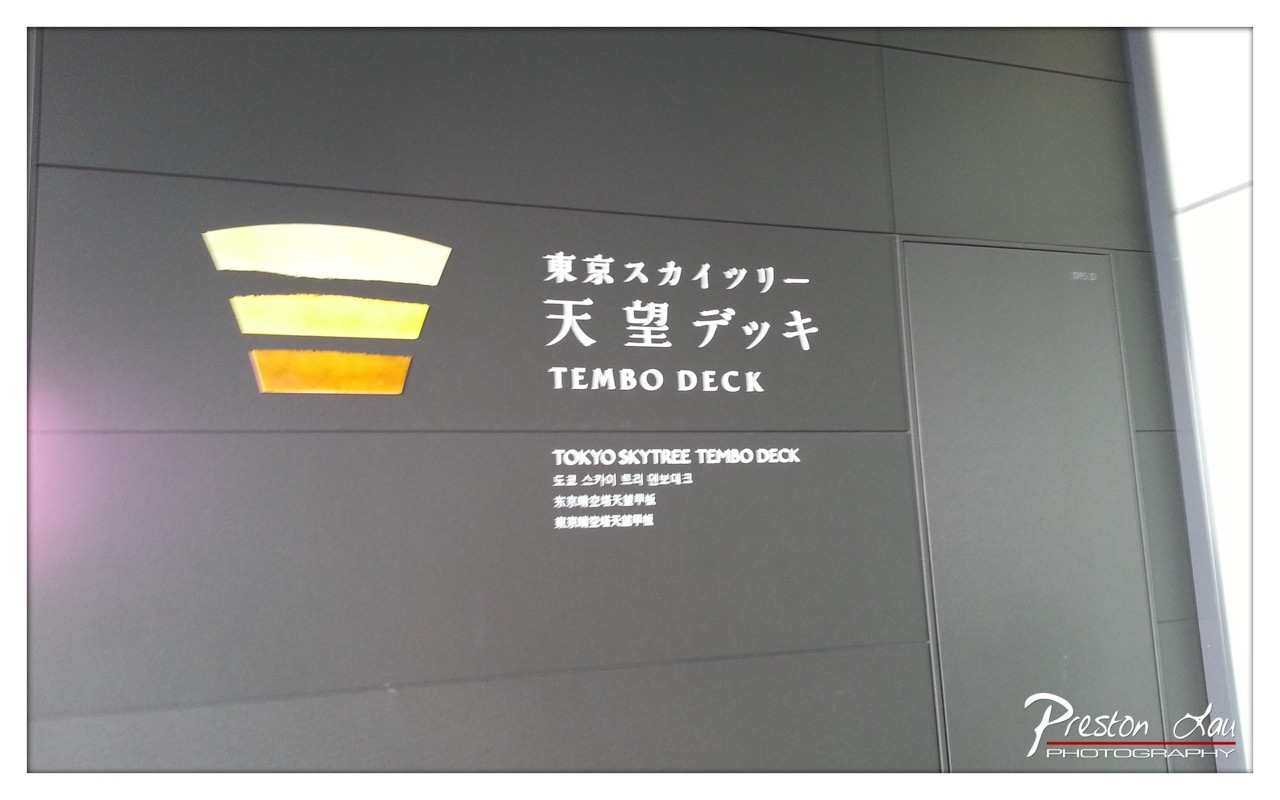

1. Overall Rating (0–10) — 6.0
This photograph captures the clean, modern signage of the Tokyo Skytree Tembo Deck with a sense of architectural clarity, emphasizing the structured design of the space. The composition is functional and informative, though it lacks the emotional pull to feel truly compelling. The overexposed window on the right and slight lens flare detract from the otherwise crisp and professional presentation.
2. Composition (0–10) — 6.0
The subject is centered and well-framed, with the signage occupying the left and center of the image, creating a balanced composition. However, the large blank space on the right and the intrusion of the bright window disrupt visual harmony and draw attention away from the focal point.
3. Lighting (0–10) — 5.5
The lighting is flat and evenly distributed across the sign, ensuring legibility. However, the harsh light from the right introduces a noticeable lens flare and overexposure, which compromises the image's tonal range and mood.
4. Color & Tone (0–10) — 6.0
The palette is restrained and monochromatic, dominated by dark gray and white, with a subtle warm accent from the yellow-lit logo. While the colors are cohesive, they lack vibrancy, giving the image a neutral, documentary feel.
5. Creativity (0–10) — 5.5
The image is straightforward and documentary in nature, focusing on clarity and identification rather than artistic expression. The multi-language text and clean design reflect practicality, but the lack of visual storytelling or unique perspective limits its creative impact.
6. Technical Quality (0–10) — 7.5
The image is sharp and well-focused, with clear text and clean lines. The resolution is high, and the detail in the signage is preserved, though the lens flare and overexposure slightly reduce overall technical refinement.
7. Emotional Impact (0–10) — 5.0
The photograph conveys a sense of order and modernity, but it feels distant and impersonal. There’s little emotional resonance, as the image functions more as an informational record than an evocative moment.
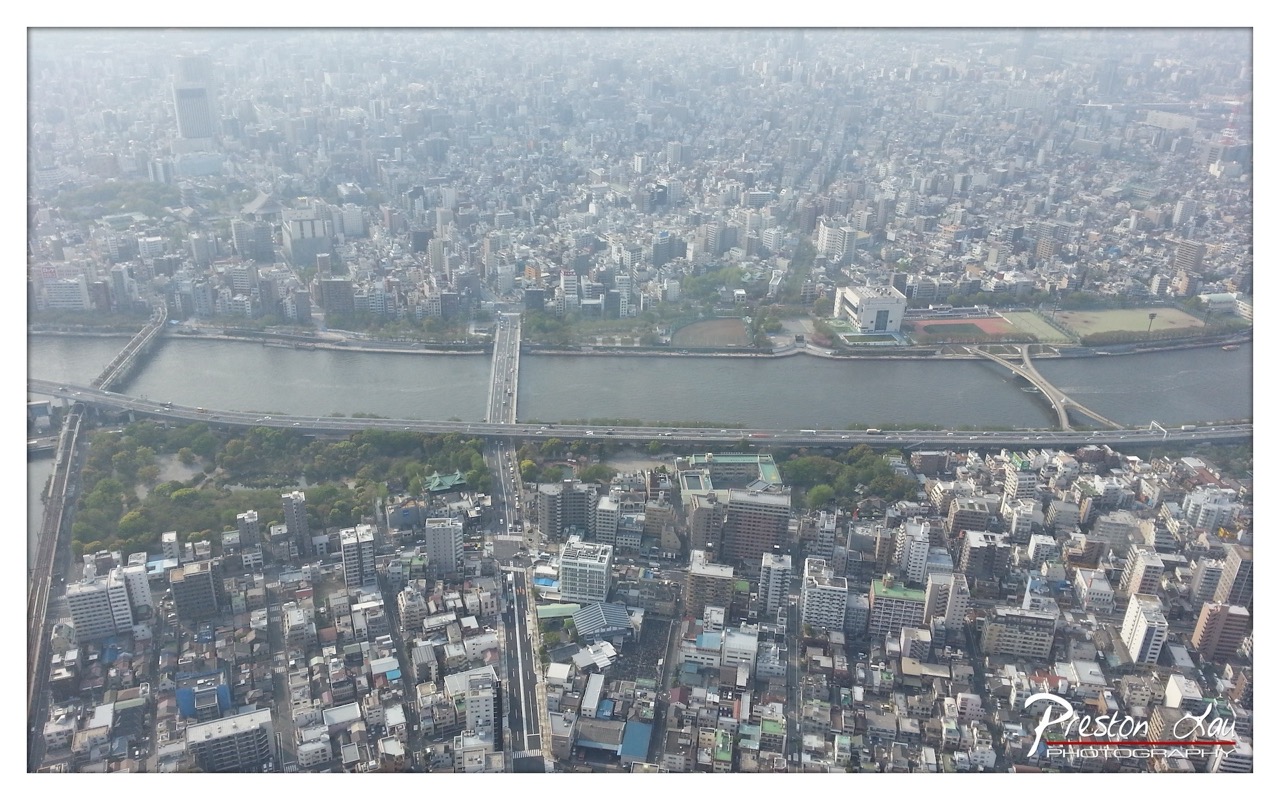

1. Overall Rating (0–10) — 7.0
This aerial view captures the sprawling density of a Japanese metropolis, where tightly packed buildings meet the flow of a river and a network of bridges. The hazy atmosphere lends a dreamlike quality, softening the urban grid and evoking a sense of both chaos and order. While the image effectively conveys the scale and complexity of the city, its muted tones and slight atmospheric distortion limit its visual punch, leaving room for greater clarity and emotional resonance.
2. Composition (0–10) — 7.5
The diagonal flow of the river and bridges guides the eye through the frame, creating a dynamic structure. The high vantage point offers a comprehensive view, though the sheer density of buildings in the foreground slightly overwhelms the composition, reducing visual breathing room.
3. Lighting (0–10) — 6.0
The soft, diffused light from an overcast or hazy day flattens shadows and reduces contrast, lending a uniform but somewhat lifeless quality to the scene. While it suits the atmospheric mood, it diminishes the sense of depth and dimension.
4. Color & Tone (0–10) — 6.5
The palette is dominated by neutral grays and muted earth tones, with subtle pops of green from trees and red from the athletic field. The overall tone is subdued, which enhances the contemplative mood but sacrifices vibrancy and visual energy.
5. Creativity (0–10) — 7.0
The perspective offers a compelling urban landscape, emphasizing the relationship between nature and infrastructure. The choice to capture the city from above with a hazy filter adds a layer of poetic abstraction, suggesting the weight and rhythm of urban life.
6. Technical Quality (0–10) — 7.5
The image is sharp and well-focused, with clean detail throughout the frame. The watermark is discreet and does not distract, and the exposure is balanced, though the haze slightly limits clarity in the background.
7. Emotional Impact (0–10) — 6.5
The photograph evokes a quiet introspection, capturing the vastness and complexity of city life. While it conveys a sense of scale and quiet endurance, it remains somewhat distant, inviting observation rather than deep emotional connection.
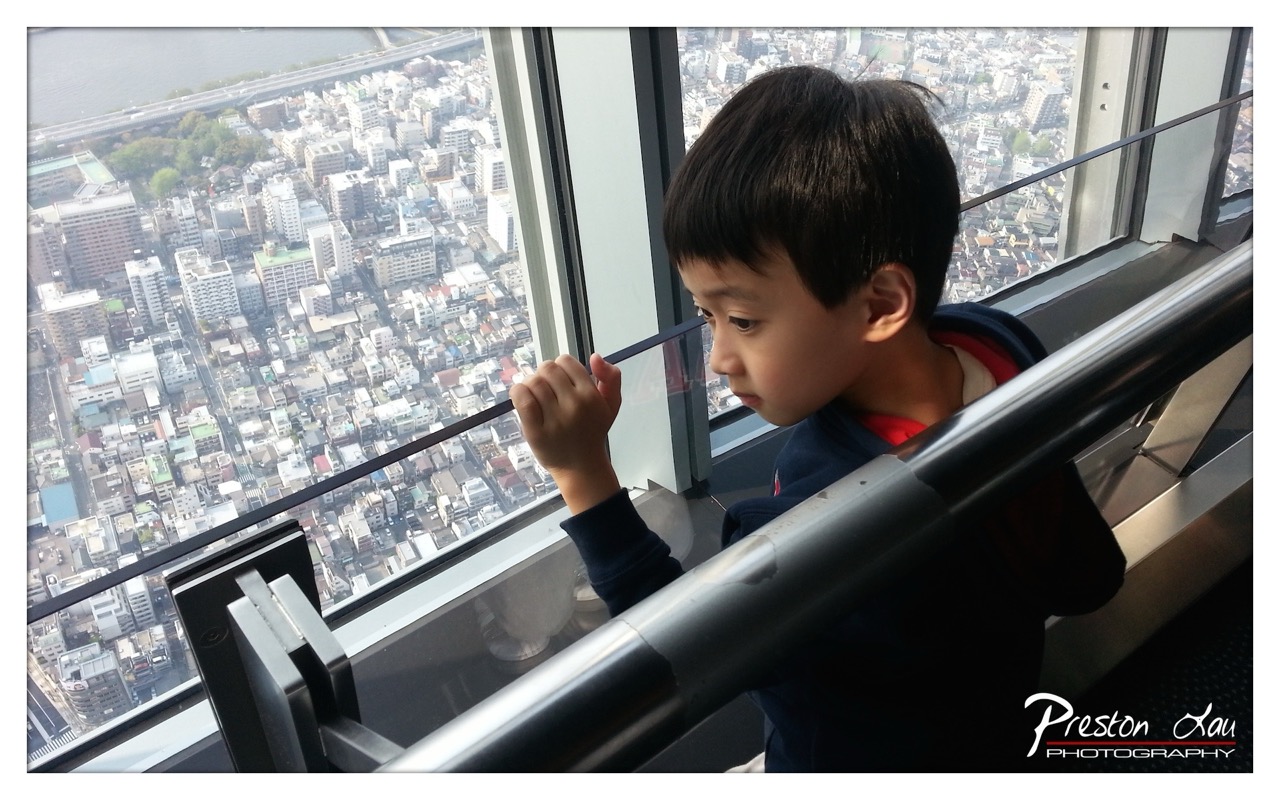

1. Overall Rating (0–10) — 7.0
This photograph captures a quiet moment of wonder, as a young boy peers out over a sprawling urban landscape from a high vantage point. The juxtaposition of the child’s innocent curiosity against the vast, intricate city below creates a compelling narrative of scale and perspective. While the image is well-composed and emotionally resonant, its potential is slightly muted by a lack of dynamic lighting and a subdued color palette.
2. Composition (0–10) — 7.5
The boy is positioned off-center, drawing the eye toward the expansive cityscape through his gaze. The diagonal rail adds a strong compositional line, guiding the viewer’s attention from foreground to background. The framing effectively uses negative space to emphasize the scale of the city and the child’s smallness within it.
3. Lighting (0–10) — 6.0
Natural daylight illuminates the scene evenly, but the light is somewhat flat and diffused, lacking strong direction or contrast. This soft quality minimizes shadows and depth, giving the image a slightly neutral tone that undercuts the potential drama of the high-altitude setting.
4. Color & Tone (0–10) — 6.5
The palette is dominated by cool grays and muted tones of the urban environment, with a subtle contrast provided by the boy’s dark jacket and red collar. While the colors are realistic and cohesive, they lack vibrancy, contributing to a slightly subdued emotional tone.
5. Creativity (0–10) — 7.0
The image successfully captures a universal moment of childhood awe, enhanced by the contrast between the intimate foreground and the expansive city. The photographer uses perspective and framing to tell a story of discovery and scale, offering a fresh and contemplative viewpoint.
6. Technical Quality (0–10) — 8.0
The image is sharp and well-focused, particularly on the boy’s face and hand. The depth of field is appropriate, keeping both the subject and the distant city in view. The exposure is balanced, with no significant over- or underexposed areas.
7. Emotional Impact (0–10) — 7.5
The photograph evokes a sense of wonder and introspection, inviting the viewer to consider the child’s thoughts as he takes in the world below. The quiet intensity of the moment, combined with the vastness of the city, creates a poignant emotional resonance.
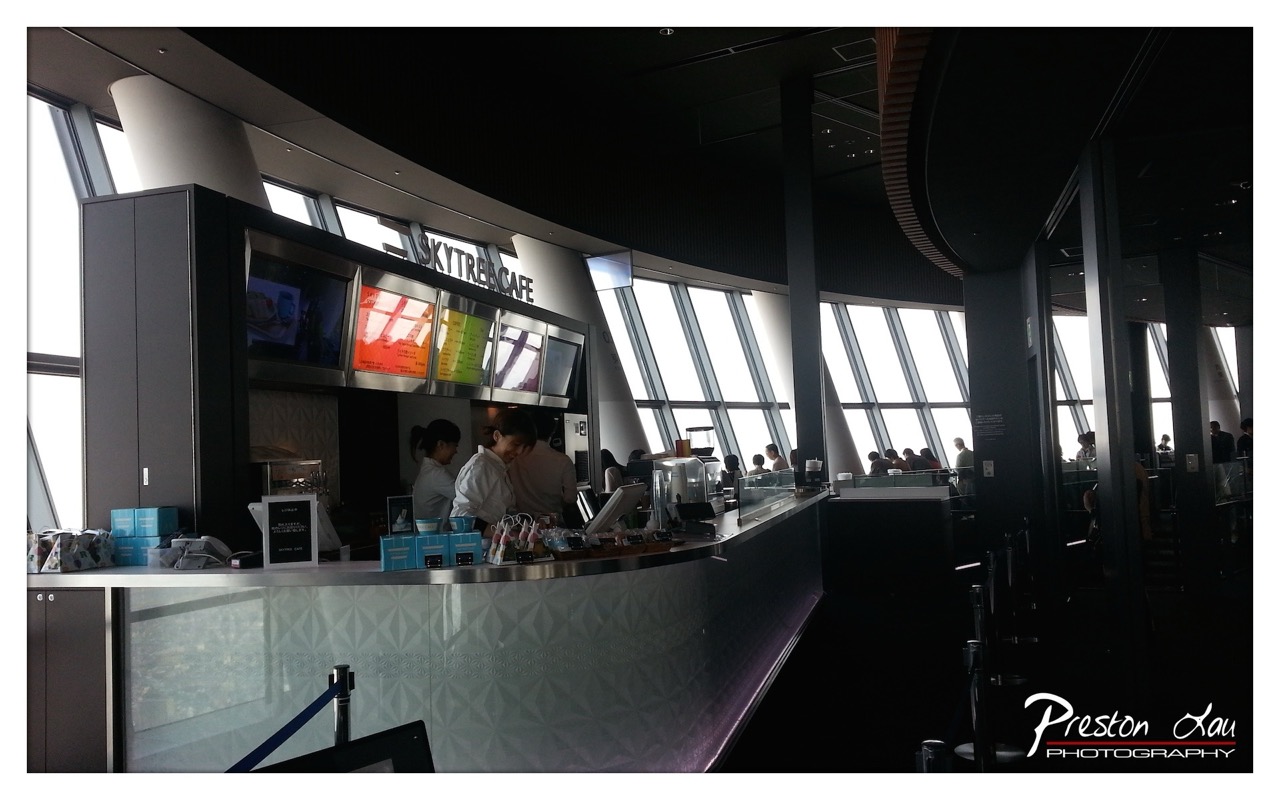

1. Overall Rating (0–10) — 6.0
This photograph captures the sleek, modern atmosphere of the Skytree Cafe, with its curved counter and panoramic windows suggesting a high-altitude experience. The interplay of light and shadow adds depth, though the heavy underexposure in the foreground dims the scene’s vibrancy. While the composition hints at a bustling, elevated café, the lack of clarity in the darker areas detracts from the overall visual impact, leaving the viewer with a sense of missed potential.
2. Composition (0–10) — 6.5
The curved counter guides the eye toward the central service area, creating a natural focal point. However, the strong diagonal lines of the windows and the cluttered foreground slightly disrupt balance, and the framing feels slightly off-center, leaving an awkward void on the right.
3. Lighting (0–10) — 5.5
The bright backlighting from the expansive windows creates high contrast, resulting in deep shadows that obscure details in the foreground. The harsh light washes out the sky outside, while the interior remains underexposed, limiting tonal range and mood.
4. Color & Tone (0–10) — 5.0
The color palette is dominated by cool grays and blacks, with muted pops of color from the menu screens. While the tones are consistent with the modern aesthetic, the lack of vibrancy and color saturation gives the image a flat, lifeless quality.
5. Creativity (0–10) — 6.0
The image successfully captures the architectural grandeur of the Skytree Cafe, leveraging its unique setting. However, the execution lacks a strong artistic vision, leaning more toward documentation than storytelling.
6. Technical Quality (0–10) — 6.5
The focus is sharp on the counter and signage, and the camera’s resolution is adequate. However, the challenging lighting conditions result in uneven exposure, with details lost in the shadows and highlights.
7. Emotional Impact (0–10) — 5.5
The photograph conveys a sense of quiet anticipation, but the heavy shadows and lack of human engagement limit emotional resonance. The viewer is invited to observe rather than feel, making the scene feel distant and impersonal.
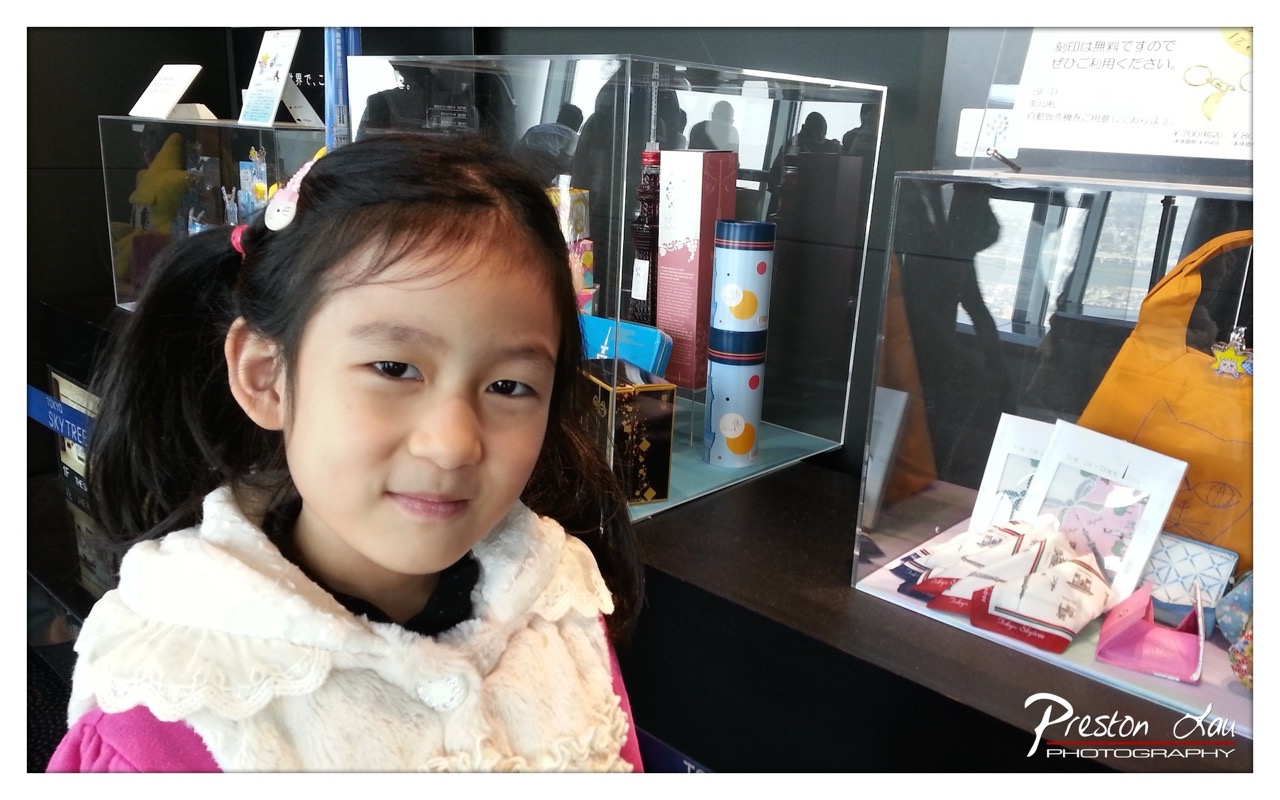

1. Overall Rating (0–10) — 7.0
This photograph captures a tender, candid moment of a young girl in a gift shop, her quiet smile radiating warmth and curiosity. The setting, filled with souvenirs and display cases, suggests a place of memory and travel, giving the image a narrative depth. While the lighting and composition are functional, the image’s charm lies in its authenticity—there’s a gentle intimacy in the way the subject engages with the camera, making it feel like a cherished snapshot rather than a staged portrait.
2. Composition (0–10) — 6.5
The girl is slightly off-center, creating a natural, unposed feel, but the cluttered background of display cases and reflections competes for attention. A tighter crop could better isolate her as the focal point.
3. Lighting (0–10) — 6.0
The lighting is even and diffused, likely from indoor sources, which softens the subject’s features. However, the flatness of the light reduces depth and dimension, especially in the background.
4. Color & Tone (0–10) — 6.5
The palette is warm and cohesive, with soft pinks, whites, and muted tones in the background complementing the girl’s clothing. The slightly cool cast from the glass displays contrasts subtly with the warmth of the subject, adding visual interest.
5. Creativity (0–10) — 7.0
The image succeeds in capturing a personal moment within a commercial setting, transforming a simple souvenir shop into a story of travel and childhood wonder. The framing and timing reflect a thoughtful, observational approach.
6. Technical Quality (0–10) — 7.5
The focus is sharp on the girl’s face, and the details in her expression and clothing are clear. The image is well-exposed, with no obvious technical flaws like noise or blur.
7. Emotional Impact (0–10) — 7.5
The girl’s gentle expression and the intimate setting evoke a sense of nostalgia and innocence. The viewer is drawn into the quiet joy of a child’s experience, creating a strong emotional connection.
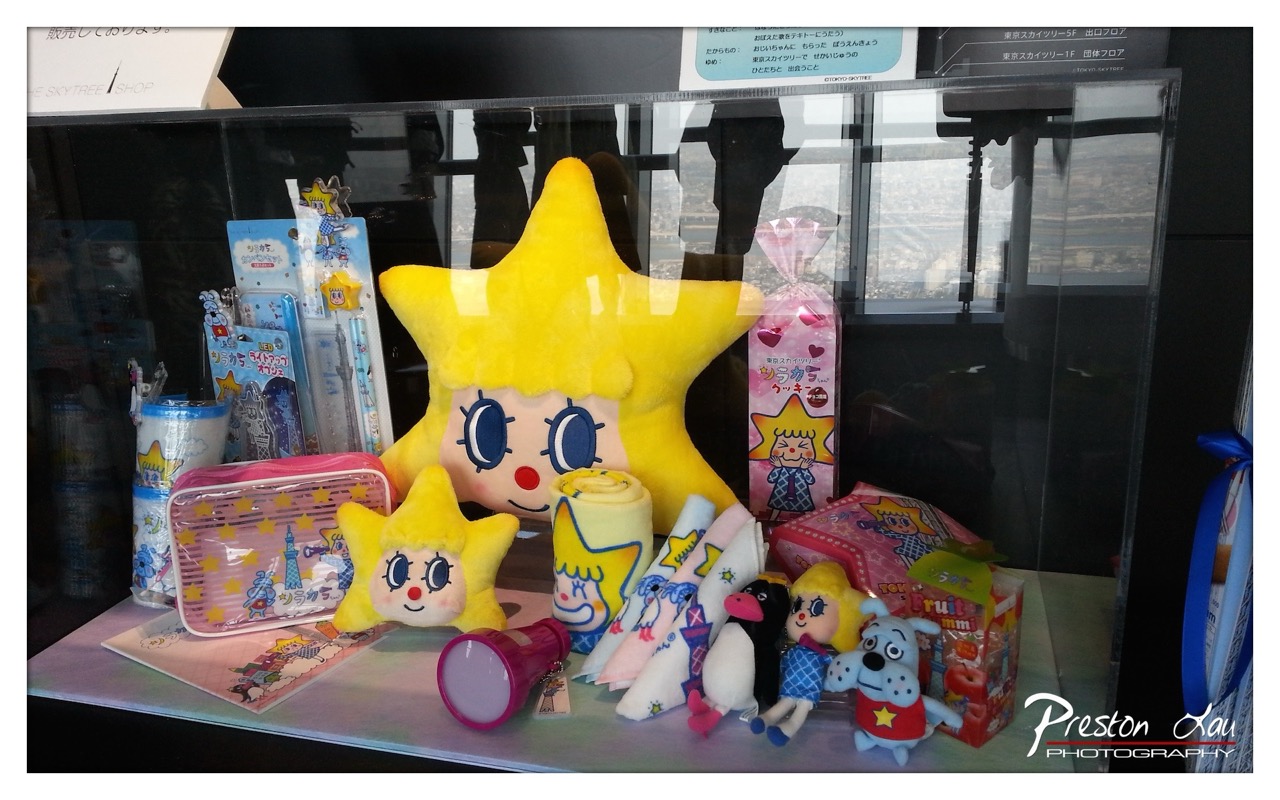

1. Overall Rating (0–10) — 6.0
This photograph captures a vibrant display of themed merchandise, offering a playful glimpse into a pop-culture retail environment. The cheerful, cartoonish aesthetic of the products is well-represented, with a strong sense of branding and character. However, the cluttered arrangement and prominent reflections in the glass detract from the clarity and visual harmony, making the scene feel more like a snapshot than a polished composition.
2. Composition (0–10) — 5.5
The framing is tight and somewhat crowded, with items overlapping and competing for attention. The central star-shaped plush serves as a focal point, but the uneven distribution of objects creates visual imbalance, and the reflections in the glass further disrupt the composition.
3. Lighting (0–10) — 5.0
The lighting is flat and diffused, likely from ambient indoor sources, which results in soft shadows and muted highlights. While the merchandise is clearly visible, the lack of directional light or contrast limits depth and dimensionality.
4. Color & Tone (0–10) — 6.5
The palette is bright and playful, dominated by yellows, pinks, and blues that reflect the cheerful tone of the character branding. However, the colors appear slightly washed out due to the reflective surface and lighting, reducing their vibrancy.
5. Creativity (0–10) — 6.0
The image successfully captures the whimsical nature of the merchandise, but the approach is straightforward and documentary in style. There is little artistic interpretation, and the composition leans more toward product display than creative storytelling.
6. Technical Quality (0–10) — 6.0
The image is sharp and well-focused, with clean detail on the items. However, the reflections in the glass and slight overexposure in the background detract from overall technical polish.
7. Emotional Impact (0–10) — 5.5
The photograph evokes a sense of nostalgia and childlike delight, particularly for fans of the character. However, the clutter and reflections create a barrier to deeper emotional engagement, keeping the viewer at a surface level of observation.
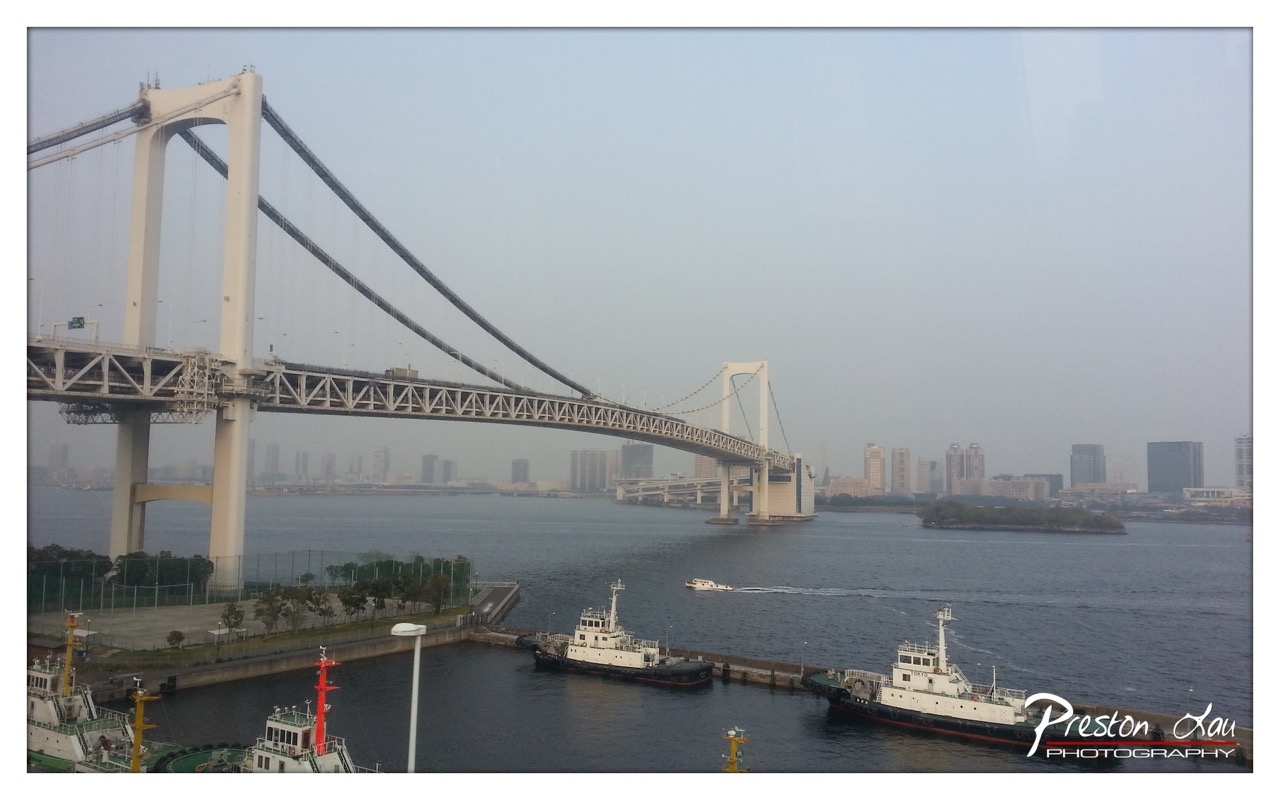

1. Overall Rating (0–10) — 6.0
This photograph captures the iconic Rainbow Bridge in Tokyo under a hazy sky, evoking a sense of urban stillness and atmospheric depth. The muted light and soft focus lend a dreamlike quality to the scene, though the image’s potential is slightly dampened by a lack of sharpness and visual tension. The composition suggests a moment of quiet observation from a high vantage point, yet it feels more like a snapshot than a fully realized image.
2. Composition (0–10) — 6.5
The bridge dominates the left and center, creating a strong diagonal that guides the eye across the frame. The inclusion of boats in the foreground adds depth, but the right side feels underdeveloped, leaving the skyline and water to occupy a passive background.
3. Lighting (0–10) — 5.5
The diffuse, overcast light creates a soft, even exposure but lacks contrast and drama. The haze reduces visibility of distant buildings and flattens the scene’s tonal range, giving it a slightly lifeless quality.
4. Color & Tone (0–10) — 5.0
The palette is muted, dominated by grays and washed-out blues, with only subtle hints of color in the boats and bridge. The lack of vibrancy diminishes the visual impact and contributes to the image’s subdued mood.
5. Creativity (0–10) — 6.0
The photograph captures a recognizable landmark with a contemplative tone, but it relies on the subject’s familiarity rather than a unique artistic vision. The framing is functional, not particularly inventive.
6. Technical Quality (0–10) — 6.0
The image is generally sharp, though the haze and possible glass reflection slightly reduce clarity. The focus is acceptable, but the overall technical execution is restrained, lacking the polish of a more refined urban landscape shot.
7. Emotional Impact (0–10) — 5.5
The image conveys a sense of calm detachment, perhaps reflecting the quiet solitude of a city viewed from a distance. While it invites contemplation, it doesn’t elicit a strong emotional response, feeling more observational than evocative.
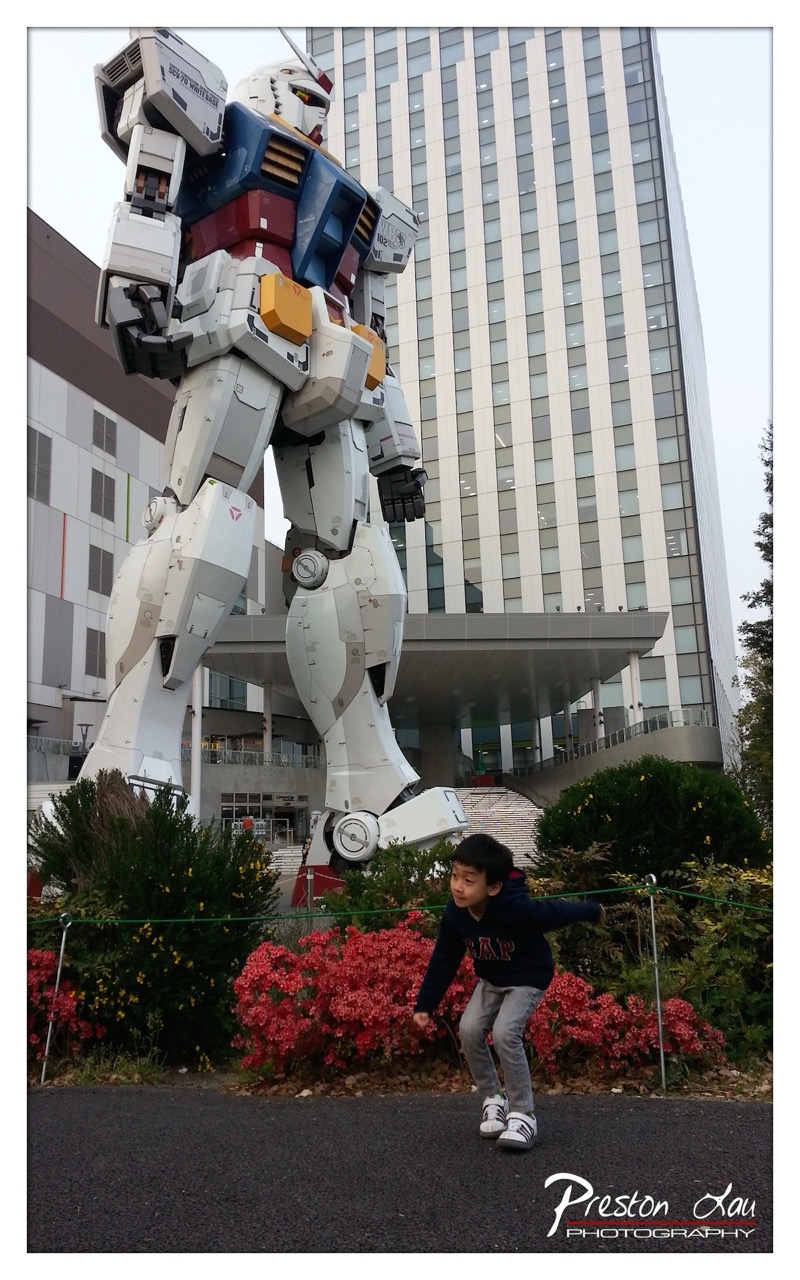

1. Overall Rating (0–10) — 7.0
This photograph captures a playful moment between a child and a towering Gundam statue, blending childhood wonder with pop-culture iconography. The contrast between the small, energetic boy and the massive mechanical figure creates a sense of scale and narrative, while the urban backdrop grounds the scene in reality. While the image succeeds in evoking a sense of joy and imagination, the composition and lighting prevent it from achieving a more refined visual impact.
2. Composition (0–10) — 6.0
The child is placed off-center, creating dynamic movement, but the towering Gundam dominates the frame, slightly overwhelming the human element. The vertical lines of the building and the robot draw the eye upward, while the foreground foliage adds depth, though it partially obstructs the base of the statue.
3. Lighting (0–10) — 5.5
The overcast sky provides soft, diffused light that evenly illuminates the scene, minimizing harsh shadows. However, the lack of strong directional light flattens the image’s depth and diminishes the dramatic presence of the robot.
4. Color & Tone (0–10) — 6.5
The bright red flowers in the foreground provide a bold contrast to the white and blue of the Gundam, drawing the eye and adding vibrancy. The muted tones of the building and the boy’s dark clothing create a balanced palette, though the overall color grading feels slightly desaturated.
5. Creativity (0–10) — 7.5
The juxtaposition of a child’s playful energy against a legendary robotic figure offers a fresh and whimsical narrative. The photographer captures a genuine moment of awe, turning a tourist snapshot into a story of imagination and scale.
6. Technical Quality (0–10) — 7.5
The focus is sharp on the child and the Gundam, with clear detail in the robot’s armor and the surrounding foliage. The image is well-exposed, though a slightly higher contrast could enhance texture and depth.
7. Emotional Impact (0–10) — 7.0
The photograph evokes a sense of childlike wonder and fascination, capturing the joy of encountering something extraordinary. The viewer is drawn into the moment, imagining the boy’s excitement as he poses with the giant robot, making it a memorable and heartwarming image.
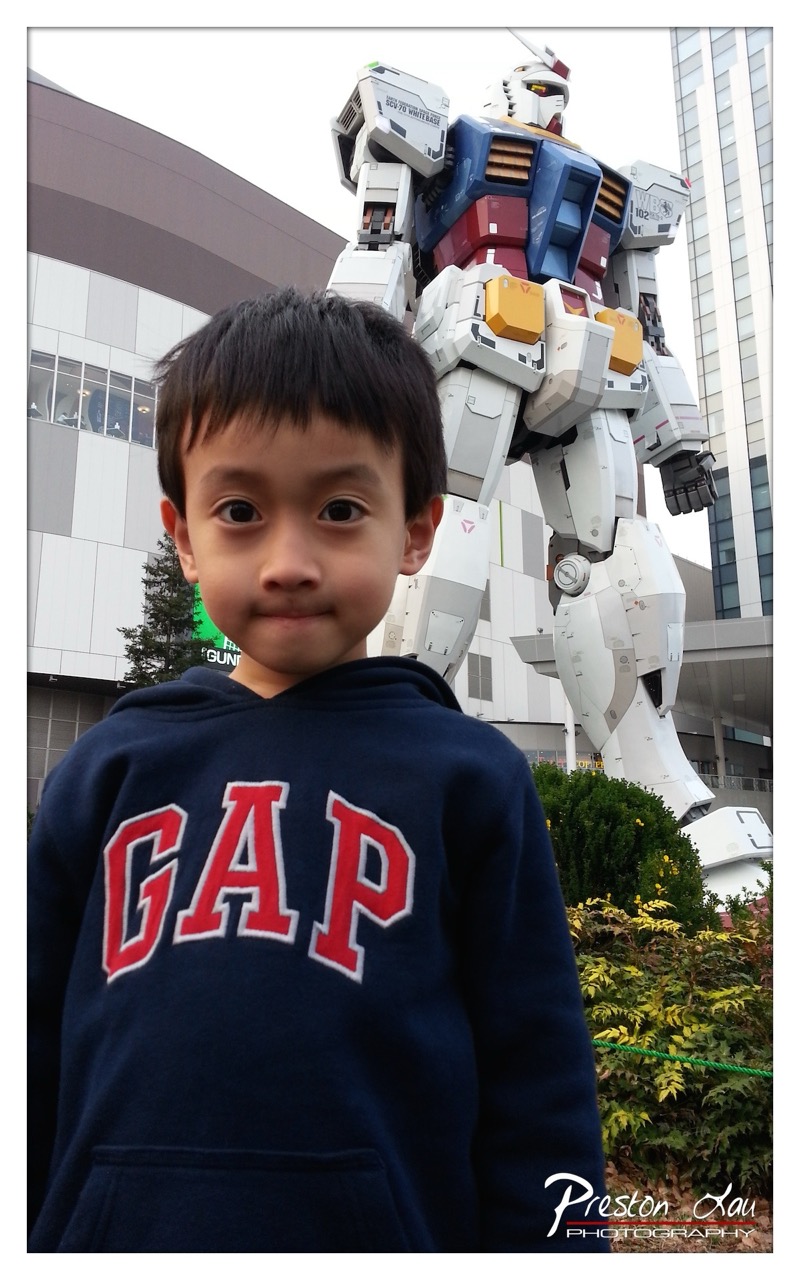

1. Overall Rating (0–10) — 7.0
This photograph captures a moment of youthful wonder juxtaposed against a towering mecha statue, creating a playful contrast between innocence and futuristic design. The child’s direct gaze and subtle smile lend warmth and personality to the scene, while the imposing Gundam figure grounds the image in pop culture nostalgia. While the composition is slightly unbalanced and the lighting is flat, the photo succeeds as a charming, personal snapshot that feels both candid and meaningful.
2. Composition (0–10) — 6.5
The boy is centered in the foreground, drawing immediate attention, but the towering robot behind him dominates the frame, creating a visual imbalance. The framing cuts off the top of the robot, disrupting its intended grandeur, though the inclusion of the surrounding urban architecture adds context.
3. Lighting (0–10) — 5.5
The scene is lit by diffused daylight, likely overcast, which flattens the image and minimizes shadows. While the light is even and avoids harsh glare, it lacks depth and fails to highlight the textures of the robot or the boy’s features.
4. Color & Tone (0–10) — 6.0
The dominant navy blue of the hoodie contrasts well with the white and red of the robot, but the overall palette is muted, with a cool, slightly grayish tone that dampens the vibrancy. The yellow-green foliage adds a touch of warmth, but the colors feel subdued.
5. Creativity (0–10) — 7.0
The juxtaposition of a child with a giant Gundam statue is inherently creative and evocative, tapping into themes of childhood imagination and fandom. The image feels like a personal story—perhaps a visit to a theme park or exhibition—making it both relatable and visually engaging.
6. Technical Quality (0–10) — 7.5
The focus is sharp on the boy’s face, and the image is free from noticeable noise or blur. The watermark is subtly placed, not distracting from the scene. However, the tight framing and lack of dynamic lighting limit the overall technical impact.
7. Emotional Impact (0–10) — 7.5
There is a strong sense of joy and awe in the child’s expression, which resonates with viewers nostalgic for childhood dreams or fans of anime and robotics. The image evokes a warm, sentimental feeling, capturing a fleeting moment of connection between a real child and a fictional giant.
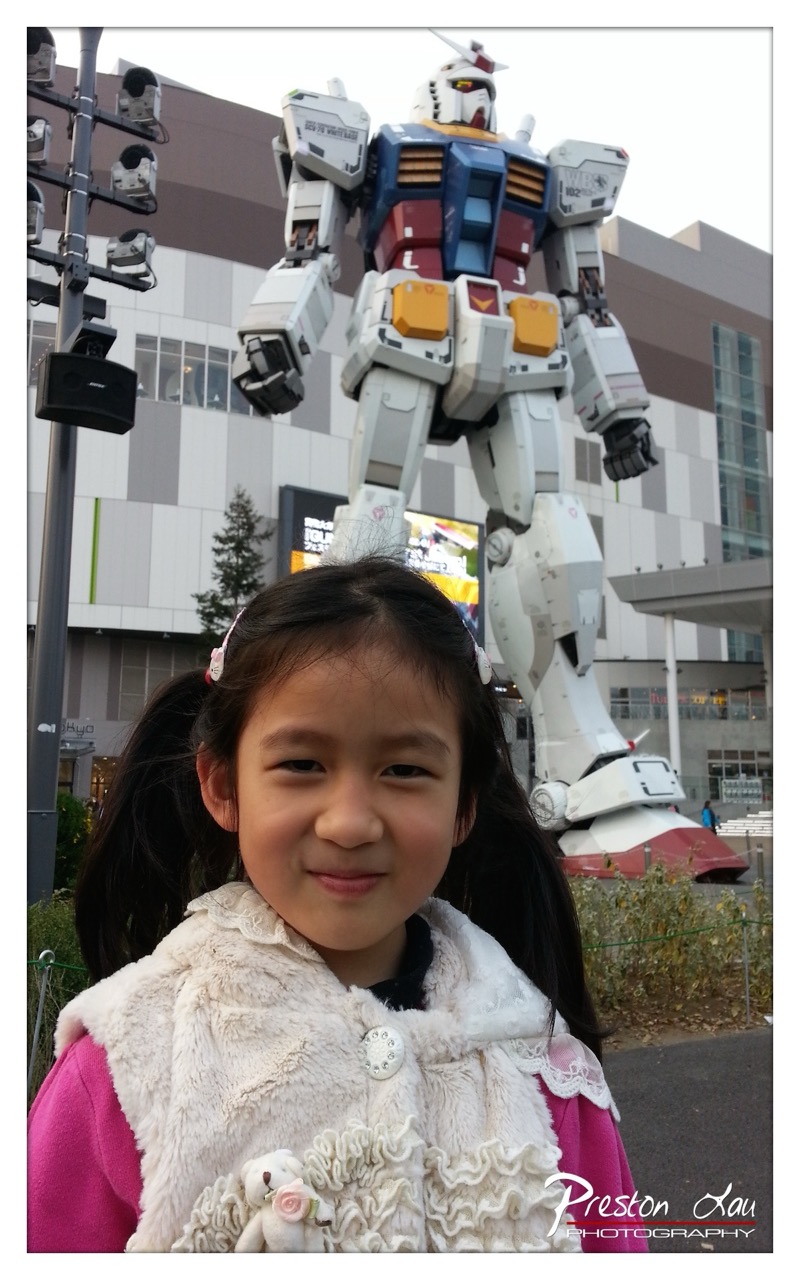

1. Overall Rating (0–10) — 7.0
This photograph captures a joyful, candid moment of a young girl posing in front of a towering Gundam statue, blending childhood wonder with pop culture iconography. The juxtaposition of the child’s soft, innocent expression against the mechanical grandeur of the robot creates a compelling narrative of awe and imagination. While the image is visually engaging and emotionally resonant, the slightly cluttered background and flat lighting prevent it from achieving a more refined aesthetic.
2. Composition (0–10) — 6.5
The girl is well-positioned in the foreground, drawing immediate attention, but the towering robot and surrounding structures create a busy backdrop that competes for focus. A tighter crop or slight shift in angle could enhance balance and emphasize the subject.
3. Lighting (0–10) — 5.5
The lighting is even and diffused, likely due to an overcast sky, which minimizes harsh shadows but also flattens the scene’s depth. While functional, it lacks the dynamic contrast that could highlight textures and mood.
4. Color & Tone (0–10) — 6.0
The color palette is moderately vibrant, with the girl’s pink sweater and the Gundam’s red and blue accents providing visual pops. However, the overall tone leans slightly cool and desaturated, reducing the warmth of the moment.
5. Creativity (0–10) — 7.5
The concept is highly creative, merging personal memory with a recognizable cultural landmark. The image tells a story of fandom, youth, and the intersection of reality and fantasy, giving it a unique and personal quality.
6. Technical Quality (0–10) — 7.0
The focus is sharp on the girl’s face, and the details in her clothing and the robot are clear. The image is well-exposed, though some minor noise is present in the background.
7. Emotional Impact (0–10) — 7.5
The photograph radiates warmth and joy, capturing a genuine moment of delight. The viewer is invited to share in the child’s fascination, making the image both personal and universally relatable.


1. Overall Rating (0–10) — 7.0
This photograph captures the imposing presence of a life-sized Gundam statue with a sense of awe and scale, emphasizing its role as both a cultural icon and architectural landmark. The low-angle perspective amplifies the robot’s dominance, while the muted urban backdrop grounds the image in reality. Though the composition is strong, the overcast lighting and slight clutter of signage detract from the visual clarity and emotional resonance.
2. Composition (0–10) — 7.5
The low-angle framing effectively conveys the statue’s towering scale, with the robot centered to dominate the frame. The surrounding elements—building, tree, and signage—create a balanced urban context, though the tree slightly disrupts the symmetry.
3. Lighting (0–10) — 5.5
The diffuse, overcast light flattens the image, reducing shadows and depth. While it ensures even exposure across the robot’s surface, it also diminishes the dramatic contrast and texture that would elevate the scene.
4. Color & Tone (0–10) — 6.0
The palette is dominated by the Gundam’s signature white, red, and blue, which stand out against the neutral tones of the building. However, the overall cool and washed-out tone, exacerbated by the gray sky, slightly dulls the vibrancy.
5. Creativity (0–10) — 7.0
The image successfully merges pop culture with urban photography, capturing a moment where fiction and reality intersect. The choice to frame the robot as a monumental figure in a cityscape adds narrative weight and cultural significance.
6. Technical Quality (0–10) — 7.5
The image is sharp and well-focused, with clear detail on the robot’s panels and text. The exposure is balanced, though some noise is visible in the sky due to the lighting conditions.
7. Emotional Impact (0–10) — 6.5
The photograph evokes a sense of wonder and nostalgia, particularly for fans of the Gundam franchise. The sheer size of the robot inspires awe, though the lack of dynamic lighting and human interaction tempers the emotional depth.
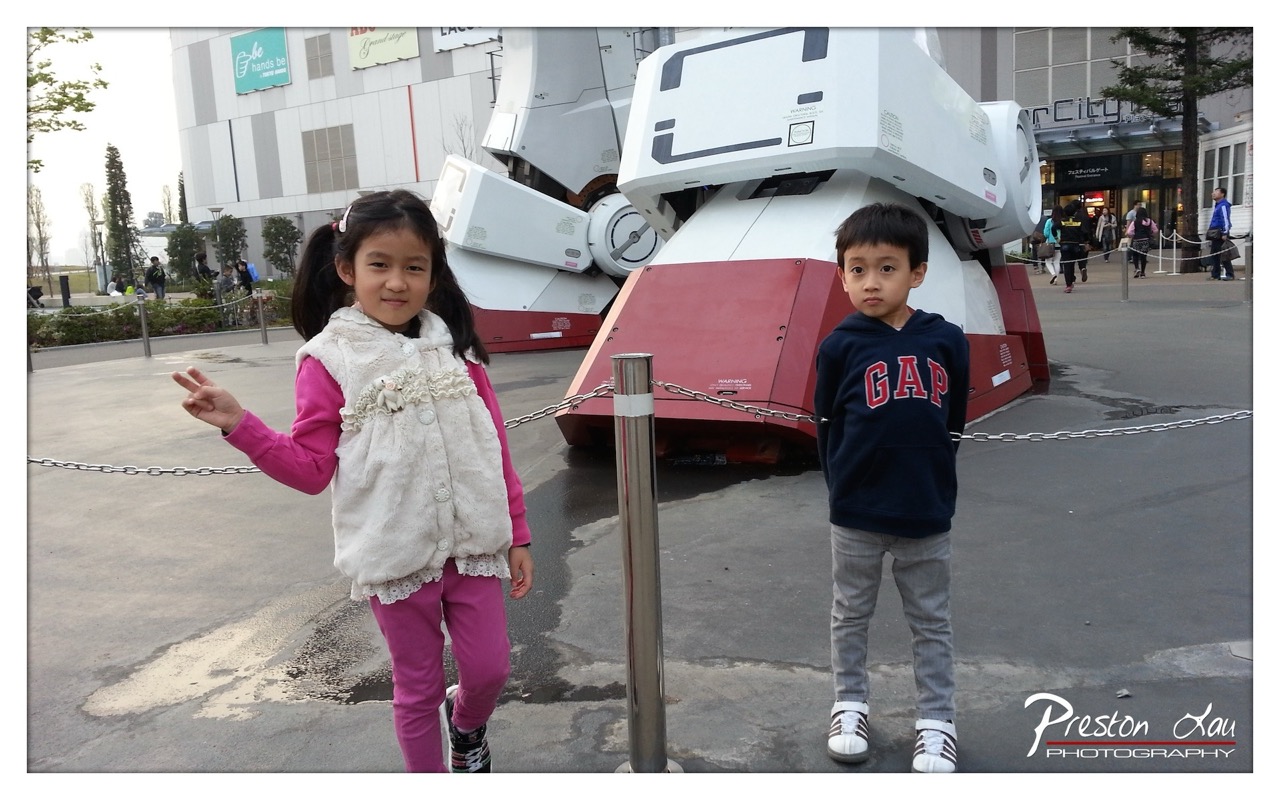

1. Overall Rating (0–10) — 6.0
This photograph captures a candid moment of two children posing in front of a large robot sculpture, evoking a sense of playful wonder and cultural curiosity. The juxtaposition of the futuristic machine with the children’s natural expressions creates a narrative of awe in a modern urban setting. While the image is engaging and conceptually strong, it is held back by flat lighting and a lack of compositional refinement that prevent it from feeling truly dynamic.
2. Composition (0–10) — 5.5
The children are placed off-center, with the girl on the left and the boy on the right, creating an asymmetrical balance. The robot dominates the background, slightly overwhelming the subjects, while the chain barrier adds a visual interruption. A tighter crop or repositioning could have better emphasized the interaction between the children and the sculpture.
3. Lighting (0–10) — 5.0
The scene is lit by overcast, diffused daylight, which flattens the image and diminishes texture and depth. While the lighting is even and avoids harsh shadows, it lacks warmth and drama, giving the photo a slightly sterile feel.
4. Color & Tone (0–10) — 6.0
The color palette is moderately vibrant, with the girl’s pink outfit providing a pop of color against the neutral tones of the robot and pavement. The red and white of the sculpture adds visual interest, but the overall tone is muted, with a slightly cool cast that undercuts the scene’s playful energy.
5. Creativity (0–10) — 7.0
The image benefits from a strong conceptual premise—children interacting with a life-sized robot, likely a cultural or entertainment attraction. The contrast between innocence and technology offers a compelling narrative, and the candid nature of the children’s expressions adds authenticity to the scene.
6. Technical Quality (0–10) — 7.0
The focus is sharp on the children and the robot, and the details in the clothing and sculpture are clear. The image is well-exposed, with no major technical flaws, though the slightly soft background and lack of depth of field keep it from feeling artistically polished.
7. Emotional Impact (0–10) — 6.5
The photo conveys a sense of joy and curiosity, particularly through the girl’s playful gesture and the boy’s more reserved expression. While the emotional connection is present, the lack of atmospheric lighting and compositional tension keeps the viewer from fully engaging with the moment.
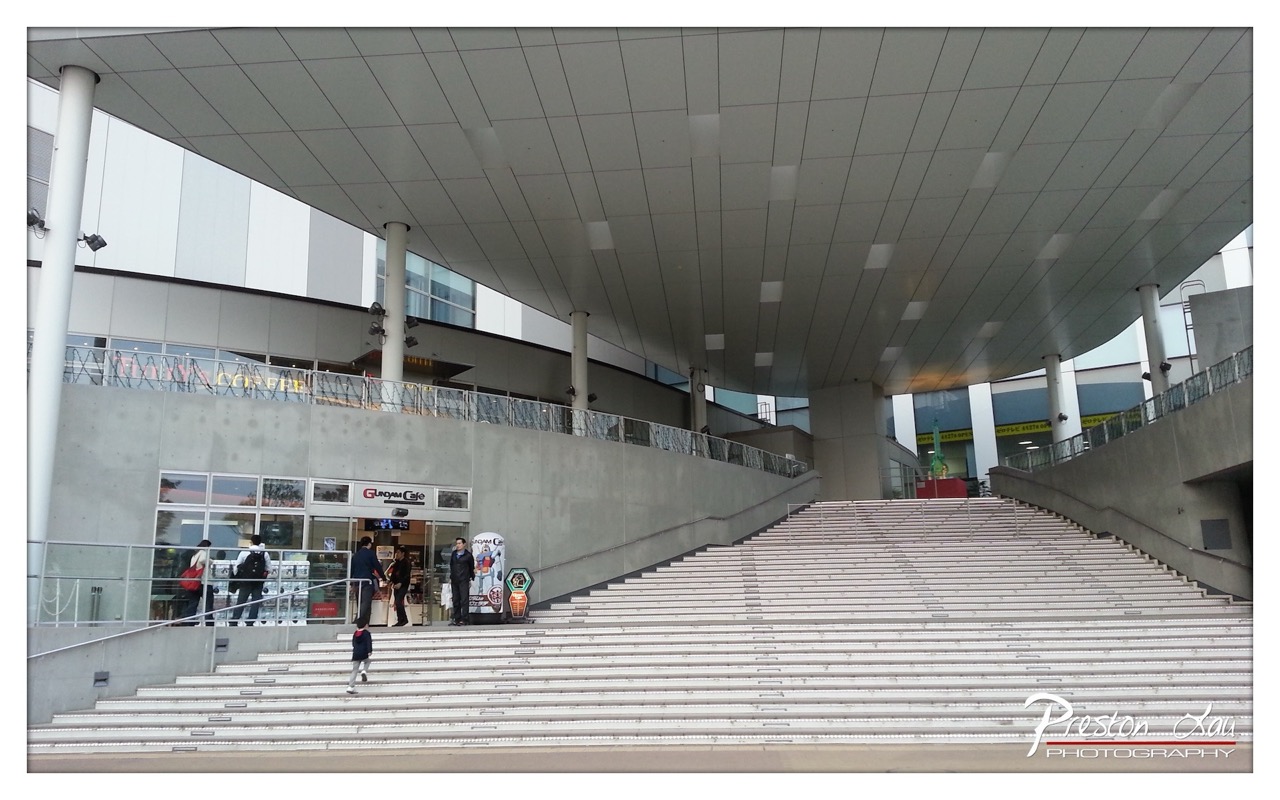

1. Overall Rating (0–10) — 6.0
This photograph captures the quiet functionality of a modern public space, where architecture and human activity intersect in a subdued rhythm. The sweeping staircase and expansive canopy create a sense of scale and movement, while the scattered figures lend a touch of life to the otherwise sterile environment. While the image effectively conveys the mood of a contemporary urban plaza, it lacks visual dynamism and emotional resonance, feeling more like an architectural snapshot than a compelling narrative.
2. Composition (0–10) — 6.0
The wide-angle perspective emphasizes the vastness of the staircase and ceiling, but the composition feels slightly unbalanced, with the left side appearing heavier due to the café and people. The diagonal lines of the steps draw the eye upward, but the lack of a clear focal point diminishes visual impact.
3. Lighting (0–10) — 5.5
Diffuse daylight provides even illumination across the scene, but the lack of strong shadows or directional light results in a flat, neutral atmosphere. The overcast conditions flatten the textures of the concrete and steel, reducing depth and mood.
4. Color & Tone (0–10) — 5.5
The palette is dominated by muted grays and whites, punctuated only by the red and yellow signage of the café. The limited color range reinforces the impersonal feel of the space, with no strong tonal contrast to draw attention or evoke emotion.
5. Creativity (0–10) — 5.5
The image is straightforward and observational, capturing a real-world scene without artistic embellishment. While the architectural lines offer visual interest, the lack of a unique perspective or interpretive angle limits its creative impact.
6. Technical Quality (0–10) — 7.5
The photograph is sharp and well-exposed, with clean details in both the foreground and background. The wide-angle lens is used effectively to capture the scale of the space, though some distortion is evident in the converging lines.
7. Emotional Impact (0–10) — 5.0
The scene evokes a sense of quiet solitude and urban routine, but it fails to elicit a strong emotional response. The distance between the viewer and the subjects, combined with the sterile environment, keeps the image emotionally detached.
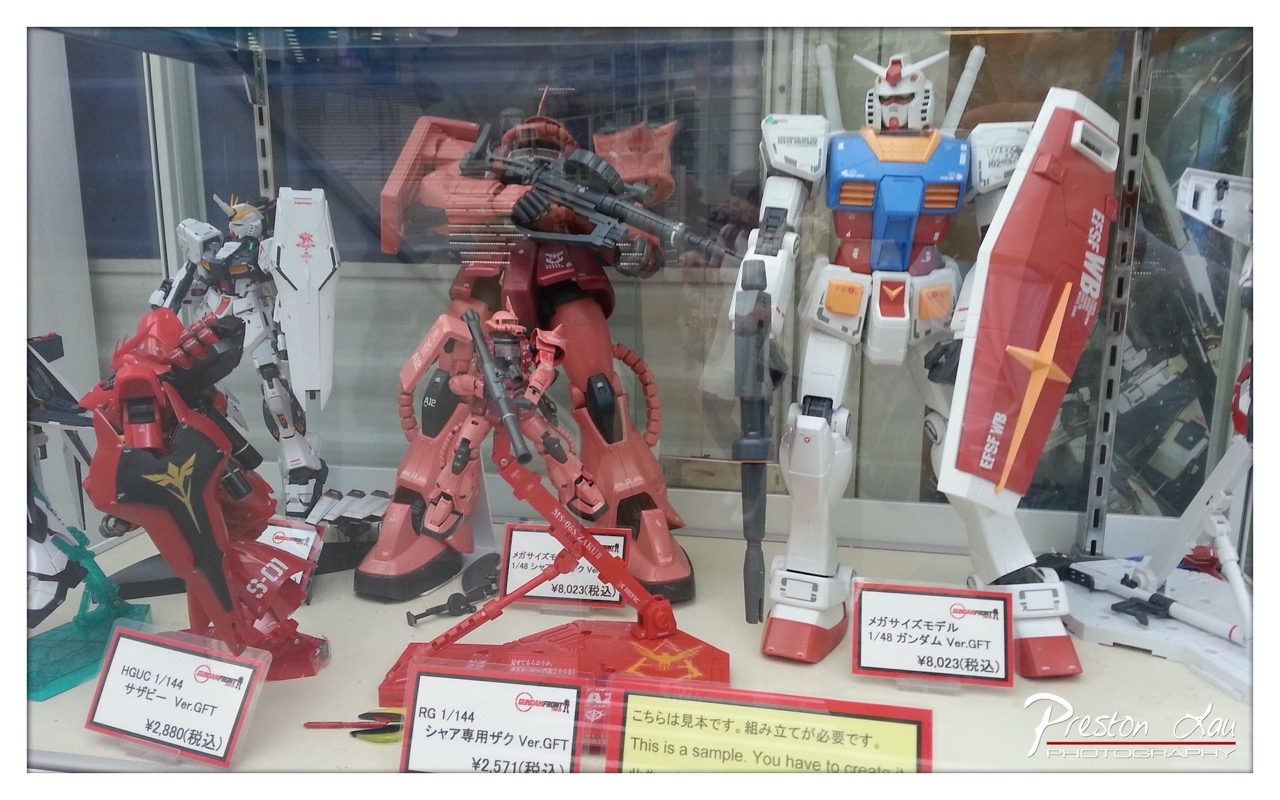

1. Overall Rating (0–10) — 6.0
This photograph captures a vibrant display of Gundam model kits in a retail setting, brimming with the energy of a collector’s passion. The colorful figures, though clearly arranged for commercial presentation, convey a sense of dynamic storytelling through their poses and scale. While the reflections in the glass and cluttered foreground detract from visual clarity, the image succeeds in documenting a niche culture with authentic enthusiasm.
2. Composition (0–10) — 5.5
The arrangement of models is visually busy, with overlapping figures and signs that disrupt the flow. A tighter framing or better alignment would improve visual hierarchy and focus.
3. Lighting (0–10) — 6.0
The lighting is bright and even, typical of a retail environment, which clearly illuminates the models but also creates reflections on the glass. The harsh overhead light flattens depth and reduces the dramatic contrast that could enhance the figures’ presence.
4. Color & Tone (0–10) — 7.0
The bold reds, whites, and blues of the models create a striking and playful palette, characteristic of the Gundam franchise. The colors are vibrant and well-saturated, though the neutral background tones and white signs slightly dilute the visual impact.
5. Creativity (0–10) — 6.5
The image reflects a strong sense of fandom and authenticity, capturing a real-world display rather than a staged scene. The arrangement tells a story of scale and variety, but the lack of a unique artistic vision keeps it more documentary than imaginative.
6. Technical Quality (0–10) — 6.5
The focus is sharp on the central figures, and the details of the models are well-captured. However, reflections on the glass and slight overexposure in bright areas reduce overall technical polish.
7. Emotional Impact (0–10) — 6.0
The image evokes a sense of nostalgia and excitement for fans of the franchise, with its familiar figures and scale models. While not emotionally charged in a cinematic way, it resonates with those familiar with the culture, offering a moment of shared enthusiasm.
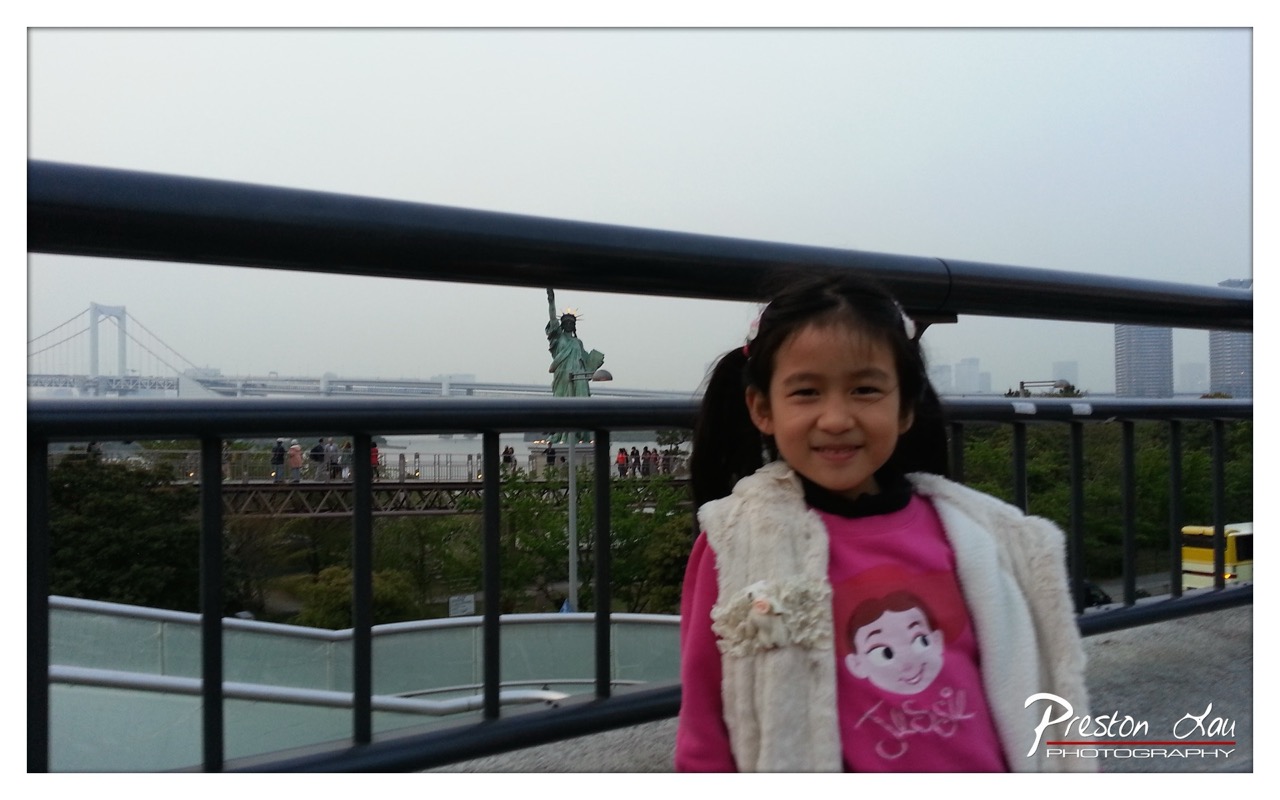

1. Overall Rating (0–10) — 6.0
This photograph captures a candid moment of youthful joy set against a distinctive urban backdrop, where a small replica of the Statue of Liberty stands beside the iconic Rainbow Bridge in Tokyo. The child’s bright smile and vibrant pink shirt inject warmth into the otherwise muted, overcast scene, creating a sense of personal memory and travel charm. While the image succeeds as a personal memento, its technical and compositional limitations—particularly the flat lighting and cluttered framing—prevent it from achieving greater visual impact.
2. Composition (0–10) — 5.5
The subject is placed off-center and partially obscured by the foreground railing, which disrupts visual flow and creates a sense of visual clutter. The railing cuts across the frame, dividing the image and drawing attention away from the subject, while the distant landmarks appear compressed and lack depth.
3. Lighting (0–10) — 4.5
The overcast sky results in flat, diffused lighting that suppresses shadows and depth, leaving the scene visually dull. The lack of directional light fails to highlight the child’s features or add dimension to the background, resulting in a muted and somewhat lifeless atmosphere.
4. Color & Tone (0–10) — 5.5
The palette is dominated by cool grays and muted greens, with the child’s pink shirt providing a stark but somewhat jarring contrast. While the color choice adds energy, the overall tonal range is compressed, and the lack of vibrancy in the surroundings diminishes the emotional resonance of the image.
5. Creativity (0–10) — 6.0
The juxtaposition of a young girl with a replica of the Statue of Liberty in Tokyo offers a playful and culturally layered narrative. The image functions as a travel memory, capturing a moment of joy in a tourist setting, but its execution lacks artistic refinement, leaning more toward documentation than creative expression.
6. Technical Quality (0–10) — 6.5
The focus is reasonably sharp on the child, and the image is free from major technical flaws like blur or noise. However, the framing and overcast conditions limit the overall clarity and visual appeal.
7. Emotional Impact (0–10) — 6.5
The child’s genuine smile and the recognizable landmarks evoke a sense of wonder and personal connection to the moment. While the emotional warmth is present, the flat lighting and composition keep the viewer at a slight remove, reducing the full emotional resonance of the scene.
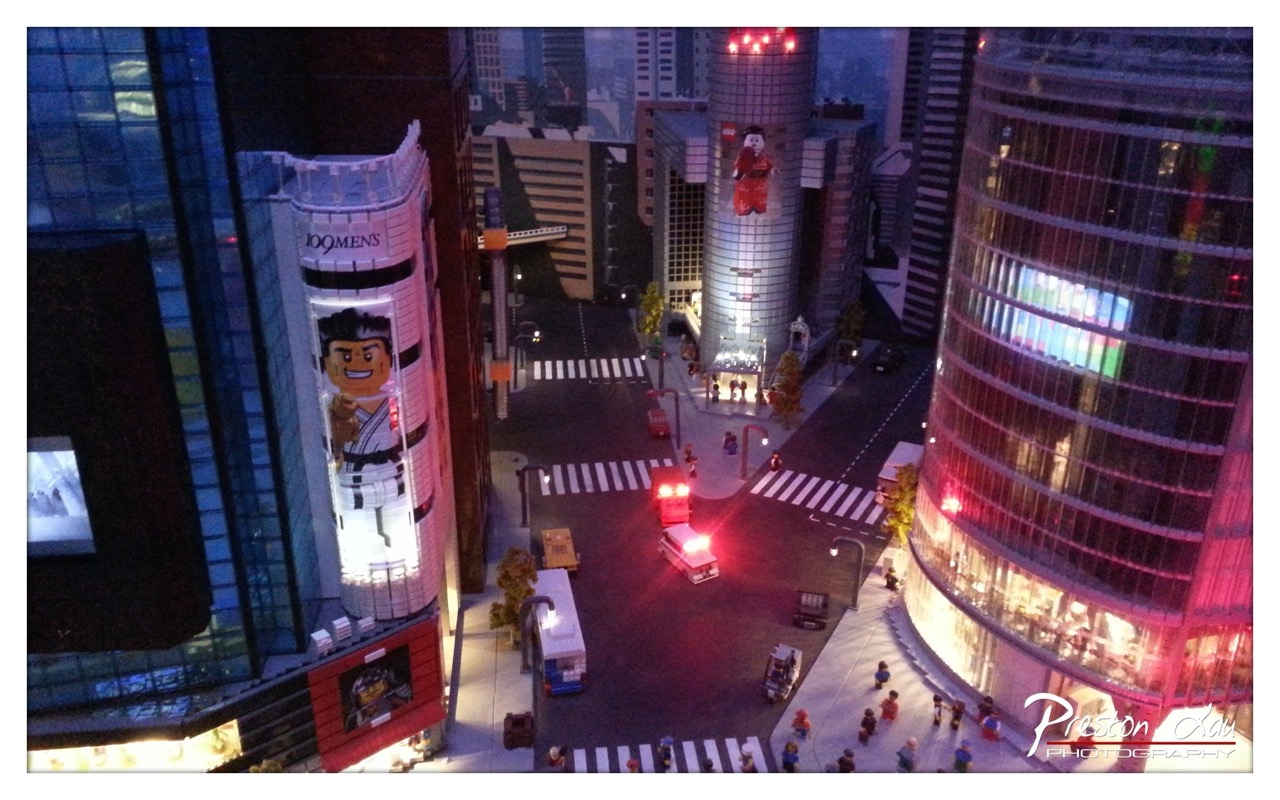

1. Overall Rating (0–10) — 7.0
This photograph captures a vibrant, meticulously crafted LEGO cityscape that evokes the energy of a bustling urban center at dusk. The scale and detail of the miniature buildings, combined with the dynamic interplay of artificial light and shadow, lend a cinematic quality to the scene. While the image is visually rich and engaging, its authenticity as a photograph of a real city is undercut by the obvious miniature nature, which creates a slight disconnect in scale and realism.
2. Composition (0–10) — 7.5
The high-angle view provides a comprehensive overview of the city block, with the street intersection serving as a natural focal point. The arrangement of buildings frames the scene effectively, guiding the eye toward the central crosswalk and the glowing vehicles. The diagonal lines of the roads and the placement of the LEGO figures enhance depth and movement, creating a balanced and engaging layout.
3. Lighting (0–10) — 8.0
The use of artificial lighting—particularly the glowing red taillights of the vehicles, the illuminated windows of the buildings, and the soft glow from the signage—creates a compelling nighttime atmosphere. The contrast between the warm interior lights and the cool blue tones of the evening sky enhances the sense of depth and realism, effectively simulating an urban nightscape.
4. Color & Tone (0–10) — 7.5
The color palette is dominated by cool blues and purples, punctuated by warm reds and yellows from the lights, creating a visually harmonious contrast. The tones are well-balanced, with sufficient saturation to make the scene feel lively without appearing overprocessed. The interplay of light and shadow adds dimensionality and mood.
5. Creativity (0–10) — 8.5
The image demonstrates a high level of creativity in transforming a miniature LEGO model into a believable urban environment. The attention to detail—such as the inclusion of signage, traffic lights, and miniature figures—shows a strong narrative intent. The photographer’s ability to capture the illusion of a real city from a toy model is both imaginative and skillful.
6. Technical Quality (0–10) — 7.0
The photograph is sharp and well-focused, with clean detail visible in the LEGO structures and lighting elements. The exposure is appropriately balanced, capturing both the bright lights and the darker areas of the scene. The slight graininess in the background suggests a higher ISO or low-light conditions, which is acceptable given the nature of the subject.
7. Emotional Impact (0–10) — 7.0
The image evokes a sense of wonder and nostalgia, blending the familiarity of a city street with the whimsy of a LEGO world. It invites the viewer to appreciate the artistry and craftsmanship behind the model while also sparking imagination about the stories unfolding within this tiny metropolis. The emotional resonance lies in the contrast between the playful medium and the realistic portrayal.
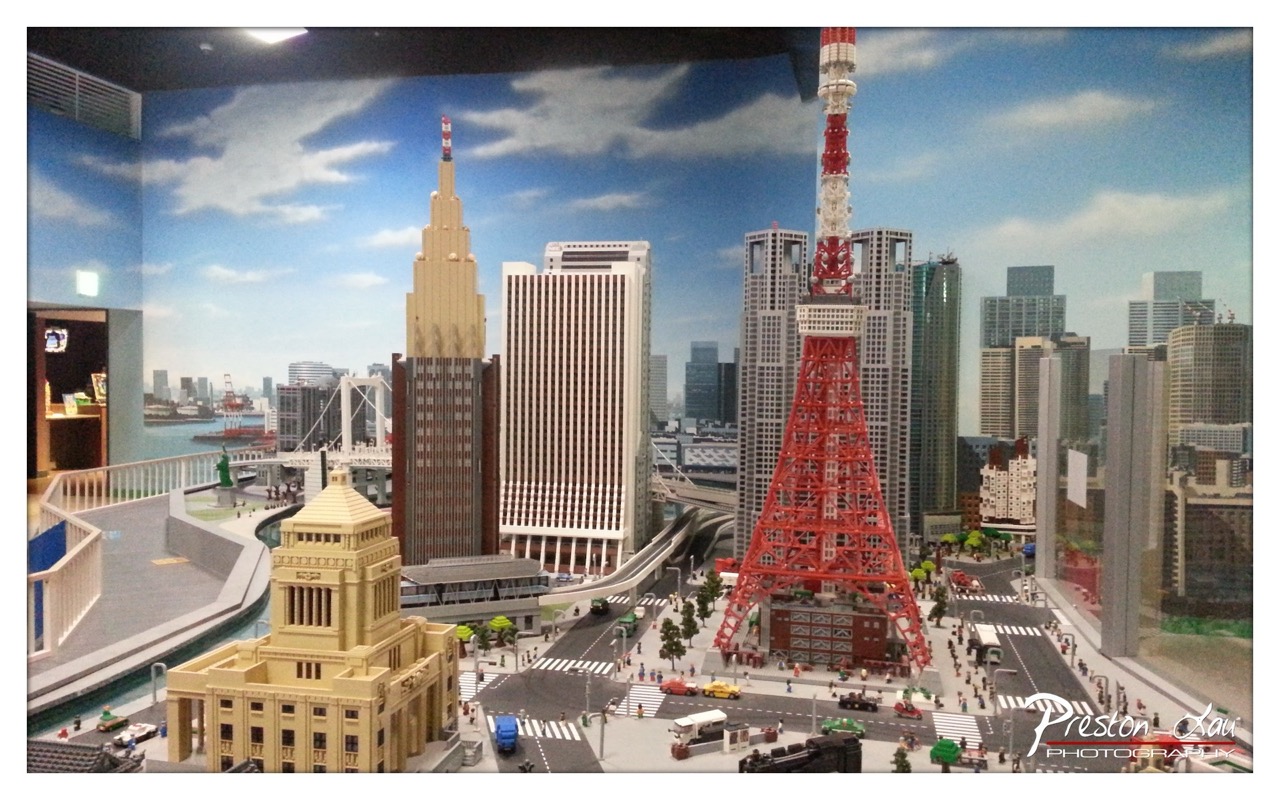

1. Overall Rating (0–10) — 7.5
This photograph captures a meticulously crafted LEGO cityscape that evokes the bustling energy of Tokyo with striking realism and playful precision. The scale and detail of the models—especially the iconic Tokyo Tower and surrounding skyscrapers—create a sense of awe, while the backdrop of a painted sky enhances the illusion of depth. The image successfully balances technical accuracy with artistic flair, though the presence of a watermark slightly detracts from its visual purity.
2. Composition (0–10) — 7.0
The framing offers a wide, panoramic view that effectively showcases the breadth of the model, with the Tokyo Tower serving as a strong focal point. The placement of the foreground building draws the eye into the scene, while the diagonal lines of the roads and bridges create dynamic movement. However, the slight asymmetry and the visible exhibit structure on the left edge introduce minor visual distractions.
3. Lighting (0–10) — 6.5
The lighting is even and bright, likely from overhead display lights, which highlights the details of the LEGO structures without casting harsh shadows. The diffuse illumination supports the clarity of the scene, though it lacks dramatic contrast or atmospheric depth that might elevate the mood.
4. Color & Tone (0–10) — 7.5
The color palette is vibrant and well-balanced, with the red of the Tokyo Tower creating a powerful visual anchor against the neutral tones of the buildings and the blue of the sky. The tonal range is broad, with clear distinctions between light and shadow, contributing to the realism of the miniature city.
5. Creativity (0–10) — 8.5
The concept of recreating a major urban landscape in LEGO is inherently imaginative and engaging. The artist’s attention to architectural accuracy and the inclusion of miniature vehicles and figures add layers of storytelling and authenticity. The blend of real-world landmarks with playful materials makes this a creative and thoughtfully executed piece.
6. Technical Quality (0–10) — 8.0
The image is sharp and well-focused, with fine detail visible in both the foreground and background elements. The depth of field is sufficient to capture the entire scene clearly, and the exposure is well-managed, avoiding overexposed highlights or crushed shadows.
7. Emotional Impact (0–10) — 7.0
The photograph evokes a sense of wonder and nostalgia, appealing to both children and adults with its celebration of craftsmanship and urban life. The scale and complexity of the model inspire admiration, while the human-like activity within the scene adds a touch of liveliness and relatability.
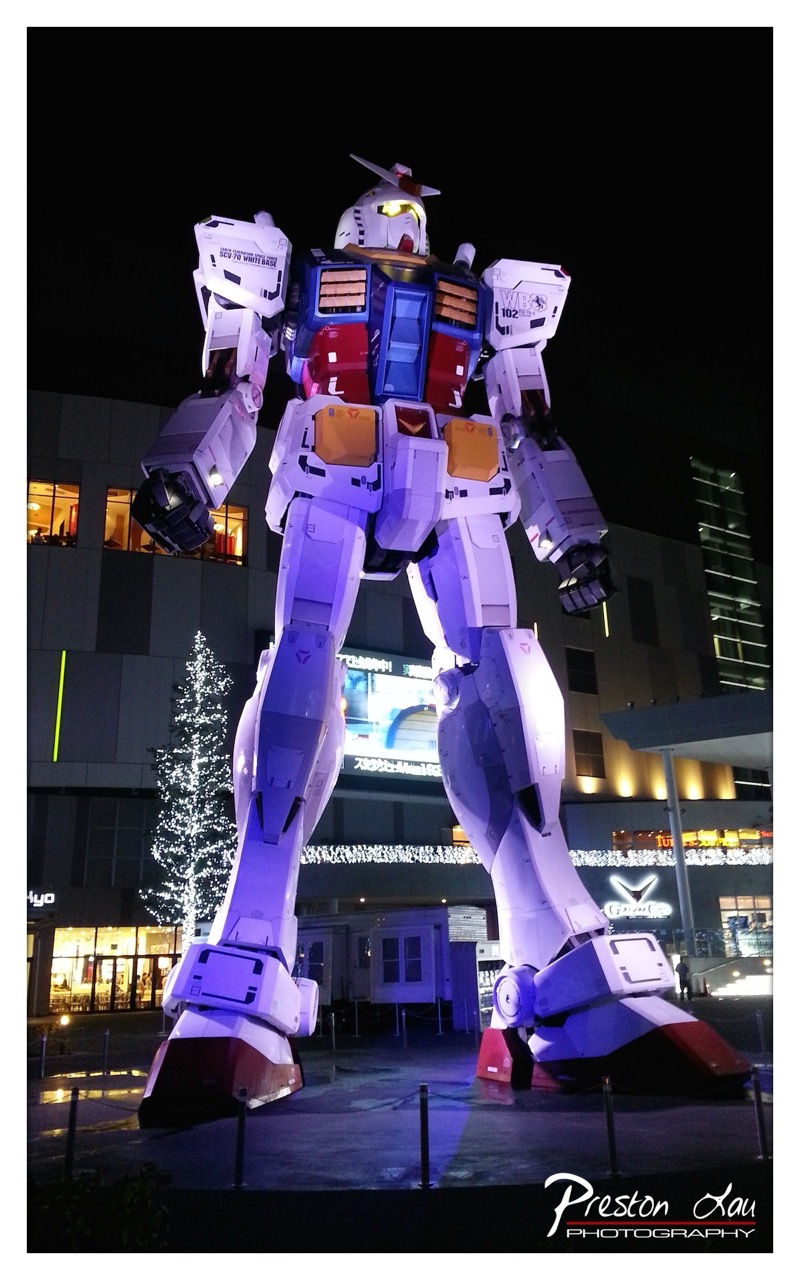

1. Overall Rating (0–10) — 7.0
This photograph captures the imposing presence of a life-sized Gundam statue under the night sky, transforming a cityscape into a futuristic stage. The dramatic lighting and low-angle perspective emphasize the robot’s scale and mechanical grandeur, while the surrounding holiday lights add a touch of warmth and contrast. Though the image is visually compelling, the composition feels slightly cluttered, and the overexposed lights detract from the subtlety of the moment.
2. Composition (0–10) — 6.5
The low-angle framing effectively conveys the statue’s towering scale, but the inclusion of too many background elements—such as the building, signage, and scattered lights—distracts from the central subject. A tighter crop would enhance focus and strengthen the sense of awe.
3. Lighting (0–10) — 7.5
The strategic use of colored lighting on the Gundam creates a dynamic and otherworldly effect, highlighting its form against the dark sky. The contrast between the cool blue and purple tones of the robot and the warm ambient glow of the surrounding lights adds depth and visual interest.
4. Color & Tone (0–10) — 7.0
The color palette balances cool purples and blues with warm yellows and whites from the background, creating a visually engaging contrast. The white Christmas lights introduce a festive warmth, while the red and blue accents on the robot enhance its iconic design.
5. Creativity (0–10) — 7.5
The image successfully blends pop culture with urban photography, turning a familiar anime icon into a monumental piece of public art. The choice to shoot at night with dramatic lighting elevates the subject beyond a mere tourist snapshot into something more cinematic and imaginative.
6. Technical Quality (0–10) — 7.5
The photograph is sharp and well-exposed, with clear details on the Gundam’s surface and clean edges. The long exposure manages light streaks and reflections effectively, though some areas of the background are slightly overexposed.
7. Emotional Impact (0–10) — 7.0
The image evokes a sense of wonder and nostalgia, appealing to fans of the Gundam franchise and lovers of sci-fi aesthetics alike. The juxtaposition of a massive, futuristic robot against a modern city at night creates a powerful emotional resonance, blending awe with a touch of melancholy.
Loading map...